二叉树
二叉树
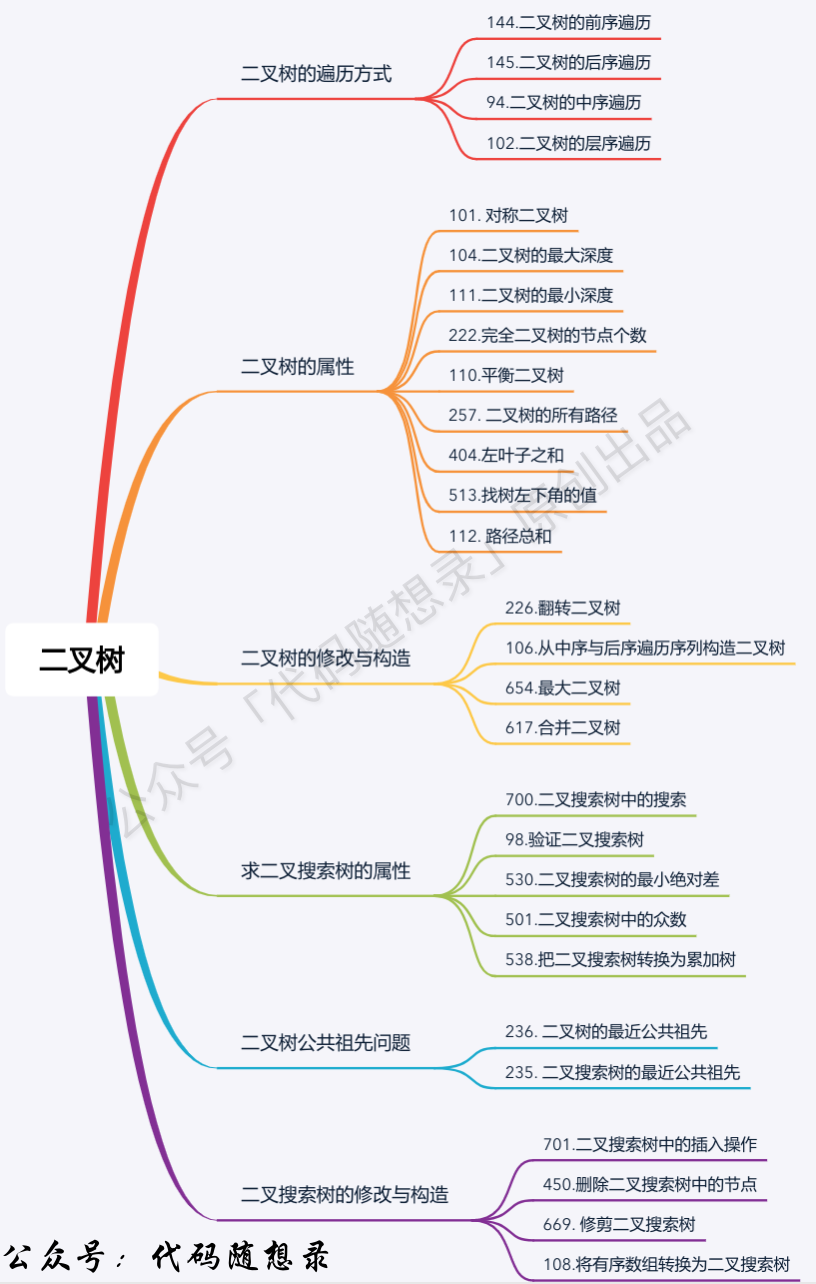
满二叉树:
- 对于k层的二叉树来说,拥有 2k -1 个结点的二叉树称为满二叉树
- 度为0的结点(叶子结点)都在同一层上
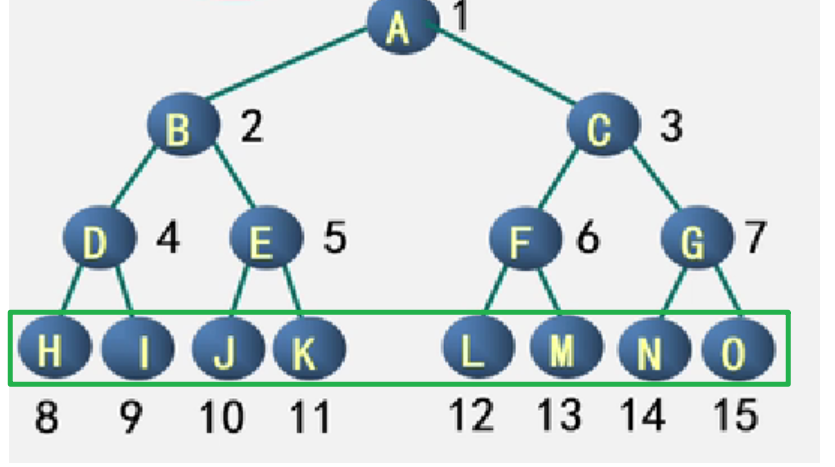
完全二叉树:
- 二叉树的结点位置按照对应的完全二叉树的位置相吻合
- 最后一层的结点,一定是从左往右依次排满的
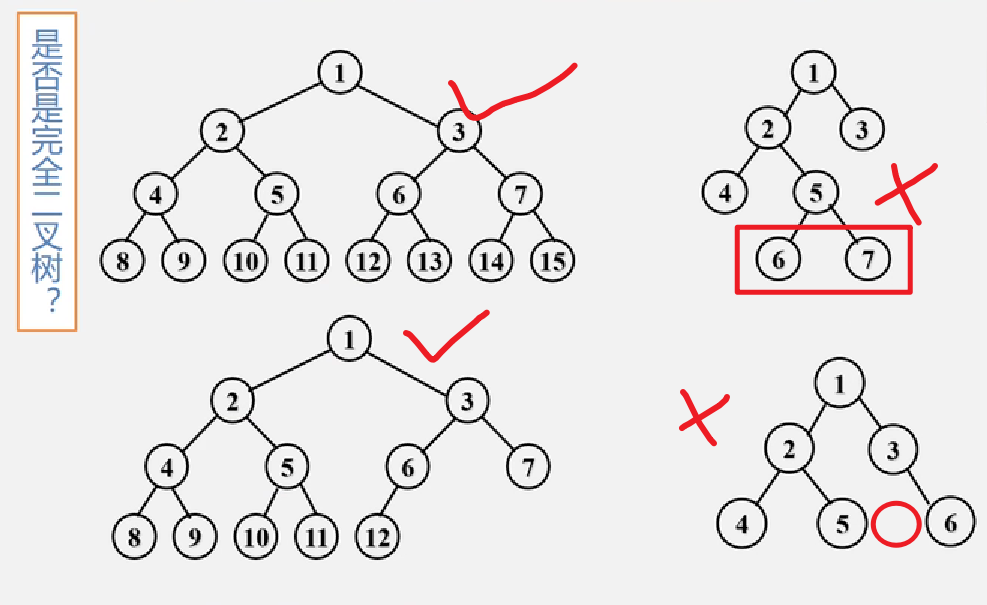
线索二叉树
若根结点的左、右子树均不为空,那么有:
- 左子树的所有结点的值均小于根结点的值
- 右子树的所有结点的值均大于根节点的值
平衡二叉树
平衡二叉树,又称AVL,一个树的左右子树的高度的差值不能大于1

二叉树的遍历
二叉树遍历方式分为三种:
- 前序遍历
- 中序遍历
- 后序遍历
每一种遍历都可以用递归和迭代俩种方法来实现,对应LeetCode题目:
1、二叉树递归遍历
递归方法比较简单,只要弄清楚结束条件即可,所谓前、中、后序遍历只不过调整加入集合的顺序即可。
前序遍历
前序遍历顺序:
- 先遍历根节点
- 在遍历左子树
- 最后遍历右子树
代码实现
定义结点
public class TreeNode {
int val;
TreeNode left;
TreeNode right;
TreeNode() {
}
TreeNode(int val) {
this.val = val;
}
TreeNode(int val, TreeNode left, TreeNode right) {
this.val = val;
this.left = left;
this.right = right;
}
}
/**
* 方法一:递归
* 根节点、左子树、右子树
* */
ArrayList<Integer> res = new ArrayList<Integer>();
public List<Integer> preorderTraversal(TreeNode root) {
if (root == null) return res;
// 先遍历根节点
res.add(root.val);
// 递归遍历左子树
preorderTraversal(root.left);
// 递归遍历左子树
preorderTraversal(root.right);
return res;
}
中序遍历
遍历顺序:
- 先遍历左子树
- 在遍历根节点
- 最后遍历右子树
ArrayList<Integer> res = new ArrayList<>();
public List<Integer> inorderTraversal(TreeNode root) {
if (root == null) return res;
// 先遍历左子树
inorderTraversal(root.left);
// 遍历根节点
res.add(root.val);
// 遍历右子树
inorderTraversal(root.right);
return res;
}
后序遍历
- 先遍历左子树
- 在遍历右子树
- 最后遍历根节点
ArrayList<Integer> res = new ArrayList<>();
public List<Integer> postorderTraversal(TreeNode root) {
if (root == null) return res;
// 先遍历左子树
postorderTraversal(root.left);
// 在遍历右子树
postorderTraversal(root.right);
// 最后遍历根节点
res.add(root.val);
return res;
}
2、二叉树迭代遍历
二叉树的迭代遍历相较于递归比较困难一些,我们知道所谓的递归,其实就是将局部变量,返回值,返回地址存放在栈中,二叉树的迭代遍历也可以用栈来实现。
前序遍历
先将根节点入栈,然后弹栈,再将右孩子结点、左孩子结点依次入栈
由于栈先进后出,所以先将右孩子放入栈中,后放左孩子
.7f471867.gif)
/**
* 方法二:迭代遍历
* */
public List<Integer> preorderTraversal2(TreeNode root) {
ArrayList<Integer> res = new ArrayList<Integer>();
if (root == null) return res;
Stack<TreeNode> stack = new Stack<>();
// 先将根节点入栈
stack.push(root);
while (!stack.isEmpty()) {
// 将根节点弹栈
TreeNode node = stack.pop();
// 将根节点加入到集合中
res.add(node.val);
// 将右孩子结点入栈,切记: 空结点不放入栈中
if (node.right != null) stack.push(node.right);
// 同理将左孩子放入栈中
if (node.left != null) stack.push(node.left);
}
return res;
}
中序遍历
在递归中我们只修改了处理结点的顺序(将节点增加到集合中),代码都一样,只是顺序改变了。
但是在迭代中,我们就无法这样做了,为什么呢?
在前序遍历中,我们访问结点和处理结点的顺序是一致的,从根结点开始访问,也是从根结点开始处理!
但是在中序遍历中,我们从根节点开始访问,但是处理的结点却是左边最底部的结点。
因此我们需要一个指针,帮助我们访问结点
.2ab8f14c.gif)
public List<Integer> inorderTraversal2(TreeNode root) {
ArrayList<Integer> res = new ArrayList<>();
if (root == null) return res;
Stack<TreeNode> stack = new Stack<>();
// 使用一个指针,帮助访问处理的结点
TreeNode cur = root;
while(cur != null || !stack.isEmpty()) {
if (cur != null) {
// 说明还未到达左边最底部的结点,继续向下访问
stack.push(cur);
// 左
cur = cur.left;
}else {
// 说明到达了左边最底部的结点,进行处理
// 中
TreeNode node = stack.pop();
res.add(node.val);
// 右
cur = node.right;
}
}
return res;
}
后序遍历
再来看后序遍历,先序遍历是中左右,后续遍历是左右中,那么我们只需要调整一下先序遍历的代码顺序,就变成中右左的遍历顺序,然后在反转 res 集合,输出的结果顺序就是左右中了,如下图:

切记: 栈的原则为先进后出,先放左,后放右,右先出,左后出!
/**
* 方法二:迭代遍历
* */
public List<Integer> postorderTraversal2(TreeNode root) {
ArrayList<Integer> res = new ArrayList<>();
if (root == null) return res;
Stack<TreeNode> stack = new Stack<>();
// 先将根节点入栈
stack.push(root);
while(!stack.isEmpty()) {
// 根
TreeNode cur = stack.pop();
res.add(cur.val);
// 左
if (cur.left != null) stack.push(cur.left);
// 右
if (cur.right != null) stack.push(cur.right);
}
// 反转
Collections.reverse(res);
return res;
}
总结
其中前序遍历和后序遍历会有一些联系,和中序遍历代码不相关。
原因就是中序遍历访问和处理的结点不是同一个,需要用额外的一个指针来访问!
3、二叉树的层序遍历
102.二叉树的层序遍历(opens new window)
给你二叉树的根节点 root ,返回其节点值的 层序遍历 。 (即逐层地,从左到右访问所有节点)。
示例 1:
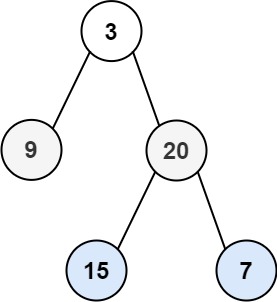
输入:root = [3,9,20,null,null,15,7]
输出:[[3],[9,20],[15,7]]
示例 2:
输入:root = [1]
输出:[[1]]
示例 3:
输入:root = []
输出:[]
提示:
- 树中节点数目在范围
[0, 2000]内 -1000 <= Node.val <= 1000
思路分析
作者:nettee 链接:https://leetcode.cn/problems/binary-tree-level-order-traversal/
DFS(深度优先搜索)和 BFS(广度优先搜索)就像孪生兄弟,提到一个总是想起另一个。然而在实际使用中,我们用 DFS 的时候远远多于 BFS。那么,是不是 BFS 就没有什么用呢?
如果我们使用 DFS/BFS 只是为了遍历一棵树、一张图上的所有结点的话,那么 DFS 和 BFS 的能力没什么差别,我们当然更倾向于更方便写、空间复杂度更低的 DFS 遍历。不过,某些使用场景是 DFS 做不到的,只能使用 BFS 遍历。这就是本文要介绍的两个场景:「层序遍历」、「最短路径」。
DFS 与 BFS
让我们先看看在二叉树上进行 DFS 遍历和 BFS 遍历的代码比较。
DFS 遍历使用 递归:
void dfs(TreeNode root) {
if (root == null) {
return;
}
dfs(root.left);
dfs(root.right);
}
BFS 遍历使用队列数据结构:
void bfs(TreeNode root) {
Queue<TreeNode> queue = new ArrayDeque<>();
queue.add(root);
while (!queue.isEmpty()) {
TreeNode node = queue.poll(); // Java 的 pop 写作 poll()
if (node.left != null) {
queue.add(node.left);
}
if (node.right != null) {
queue.add(node.right);
}
}
}
是比较两段代码的话,最直观的感受就是:DFS 遍历的代码比 BFS 简洁太多了!这是因为递归的方式隐含地使用了系统的 栈,我们不需要自己维护一个数据结构。如果只是简单地将二叉树遍历一遍,那么 DFS 显然是更方便的选择。
虽然 DFS 与 BFS 都是将二叉树的所有结点遍历了一遍,但它们遍历结点的顺序不同。
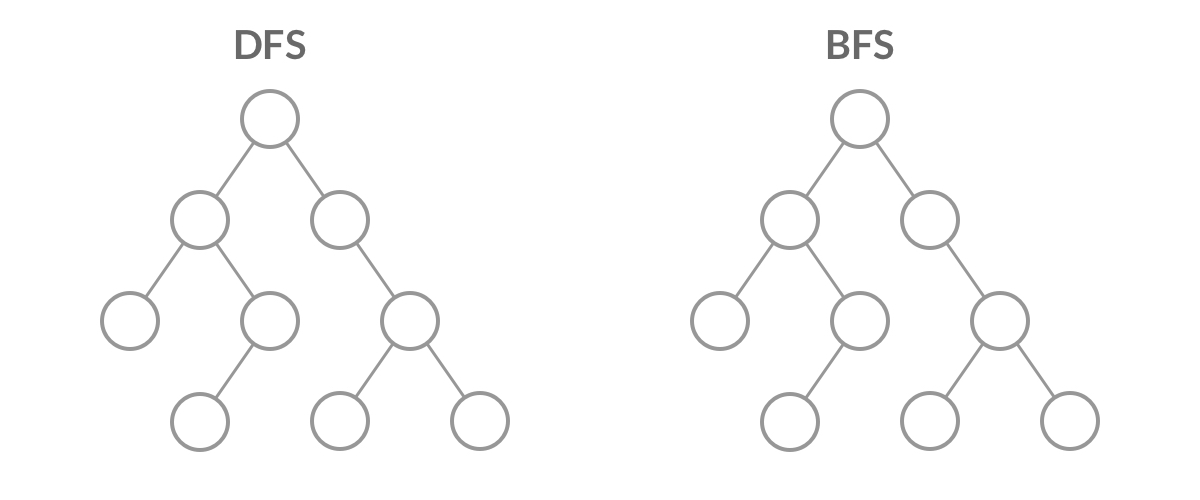
BFS应用场景: 层序遍历
什么是层序遍历?
从上至下,从左到右依次访问二叉树的每一个结点。
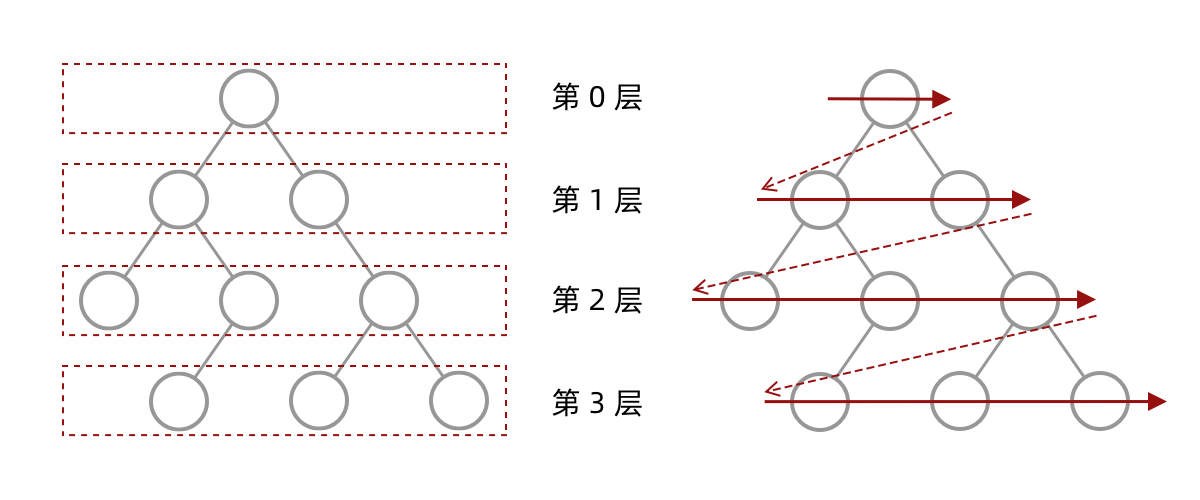
其实乍一看这个遍历顺序和 BFS(广度优先遍历)是一样的,但是与BFS不同的是,二叉树的层次遍历却是一个二维数组。而BFS 遍历后得到是一维数组,无法区分每一层
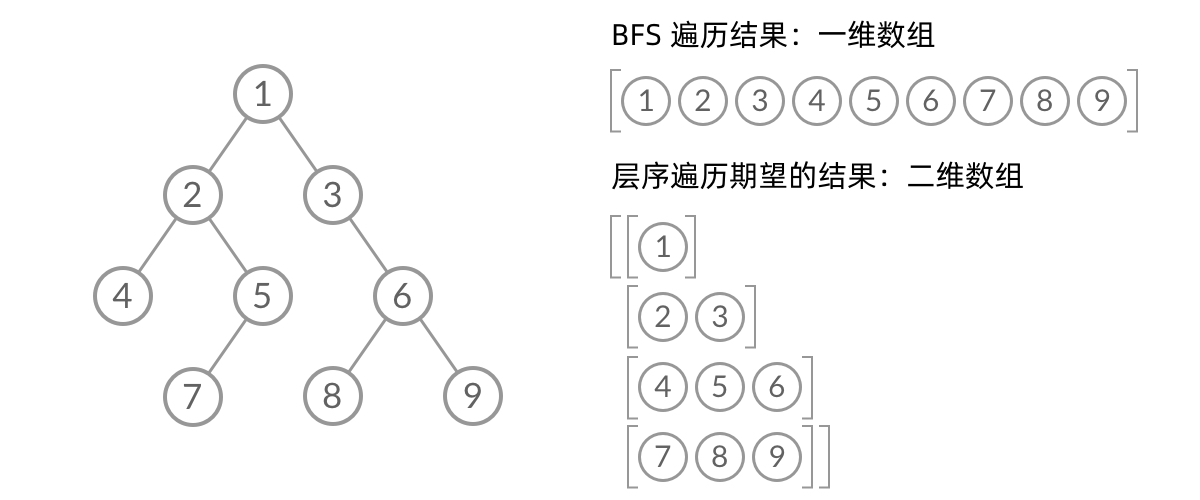
那么,怎么给 BFS 遍历的结果分层呢?我们首先来观察一下 BFS 遍历的过程中,结点进队列和出队列的过程:
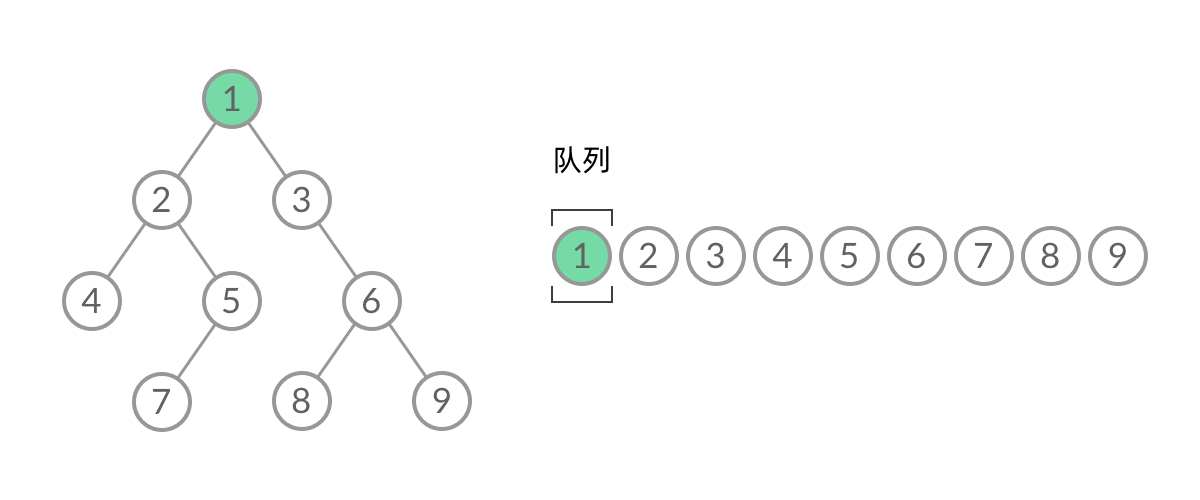
截取 BFS 遍历过程中的某一时刻:
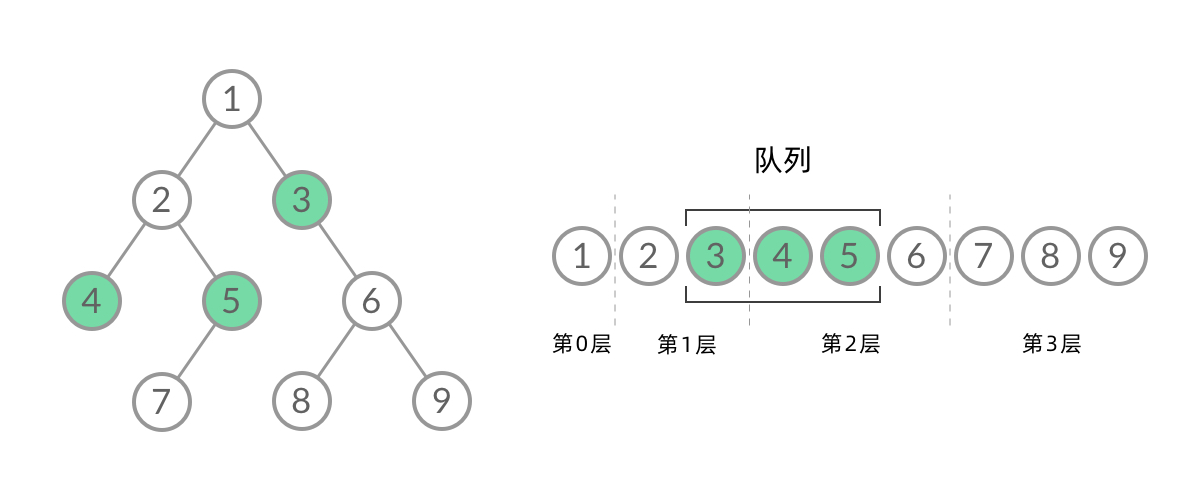
可以看到,此时队列中的结点是 3、4、5,分别来自第 1 层和第 2 层。这个时候,第 1 层的结点还没出完,第 2 层的结点就进来了,而且两层的结点在队列中紧挨在一起,我们 无法区分队列中的结点来自哪一层。
因此,我们需要稍微修改一下代码,在每一层遍历开始前,先记录队列中的结点数量 n(也就是这一层的结点数量),然后一口气处理完这一层的 n 个结点
// 二叉树的层序遍历
void bfs(TreeNode root) {
Queue<TreeNode> queue = new ArrayDeque<>();
queue.add(root);
while (!queue.isEmpty()) {
int n = queue.size();
for (int i = 0; i < n; i++) {
// 变量 i 无实际意义,只是为了循环 n 次
TreeNode node = queue.poll();
if (node.left != null) {
queue.add(node.left);
}
if (node.right != null) {
queue.add(node.right);
}
}
}
}
将BFS遍历改成了层序遍历,在遍历过程中,结点的出队入队过程为:
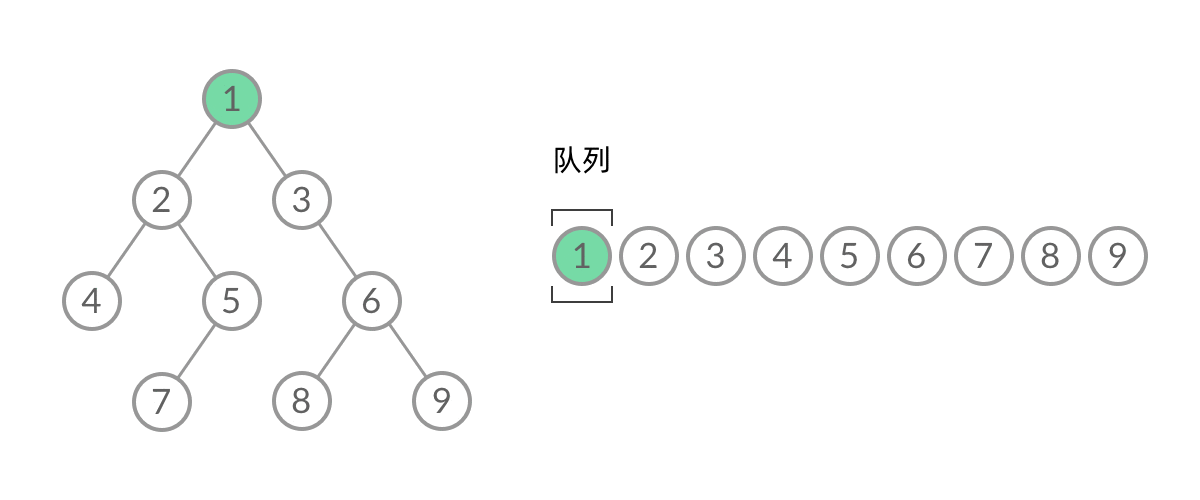
可以看到,在 while 循环的每一轮中,都是将当前层的所有结点出队列,再将下一层的所有结点入队列,这样就实现了层序遍历。
最终我们得到的题解代码为:
class Solution {
List<List<Integer>> res = new ArrayList<>();
public List<List<Integer>> levelOrder(TreeNode root) {
if (root == null) return res;
Queue<TreeNode> queue = new ArrayDeque<>();
queue.add(root);
// n记录每一层的结点个数
while(!queue.isEmpty()) {
int n = queue.size();
ArrayList<Integer> item = new ArrayList<>();
for (int i = 0; i < n; i++) {
// n 无实际意义,只是为了能够一次性将一层的结点出队
TreeNode treeNode = queue.poll();
item.add(treeNode.val);
// 将左孩子结点入队
if (treeNode.left != null) queue.add(treeNode.left);
// 将右孩子结点入队
if (treeNode.right != null) queue.add(treeNode.right);
}
res.add(item);
}
return res;
}
}
递归版本:
class Solution {
List<List<Integer>> res = new ArrayList<>();
public List<List<Integer>> levelOrder(TreeNode root) {
recursion(root, 0);
return res;
}
// deep表示遍历的层次
public void recursion(TreeNode node, int deep) {
// 终止条件
if (node == null) return;
// 没执行一次,层次加一
deep++;
if (res.size() < deep) {
// 每一层的元素加集合,当deep增加时,增加一层元素
List<Integer> item = new ArrayList<>();
res.add(item);
}
// 增加当前结点,list索引下标从0开始,所以-1
res.get(deep - 1).add(node.val);
// 遍历左子树
recursion(node.left, deep);
// 遍历右子树
recursion(node.right, deep);
}
}
107. 二叉树的层序遍历 II
给你二叉树的根节点 root ,返回其节点值 自底向上的层序遍历 。 (即按从叶子节点所在层到根节点所在的层,逐层从左向右遍历)
示例 1:
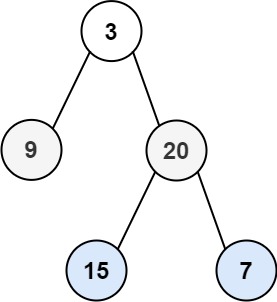
输入:root = [3,9,20,null,null,15,7]
输出:[[15,7],[9,20],[3]]
示例 2:
输入:root = [1]
输出:[[1]]
示例 3:
输入:root = []
输出:[]
提示:
- 树中节点数目在范围
[0, 2000]内 -1000 <= Node.val <= 1000
思路分析
简单一批,直接将集合反转即可
public List<List<Integer>> levelOrderBottom(TreeNode root) {
List<List<Integer>> res = new ArrayList<>();
if (root == null) return res;
Queue<TreeNode> queue = new ArrayDeque<>();
queue.add(root);
while (!queue.isEmpty()) {
int n = queue.size();
List<Integer> item = new ArrayList<>();
for (int i = 0; i < n; i++) {
TreeNode node = queue.poll();
item.add(node.val);
if (node.left != null) queue.add(node.left);
if (node.right != null) queue.add(node.right);
}
res.add(item);
}
/
Collections.reverse(res);
return res;
}
199. 二叉树的右视图
给定一个二叉树的 根节点 root,想象自己站在它的右侧,按照从顶部到底部的顺序,返回从右侧所能看到的节点值。
示例 1:
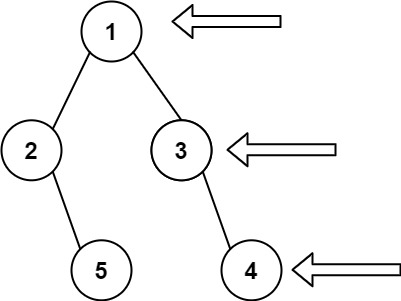
输入: [1,2,3,null,5,null,4]
输出: [1,3,4]
示例 2:
输入: [1,null,3]
输出: [1,3]
示例 3:
输入: []
输出: []
提示:
- 二叉树的节点个数的范围是
[0,100] -100 <= Node.val <= 100
思路分析
如图所示,我们只需要将层序遍历结果中,每一层的最后一个元素放入结果集中即可
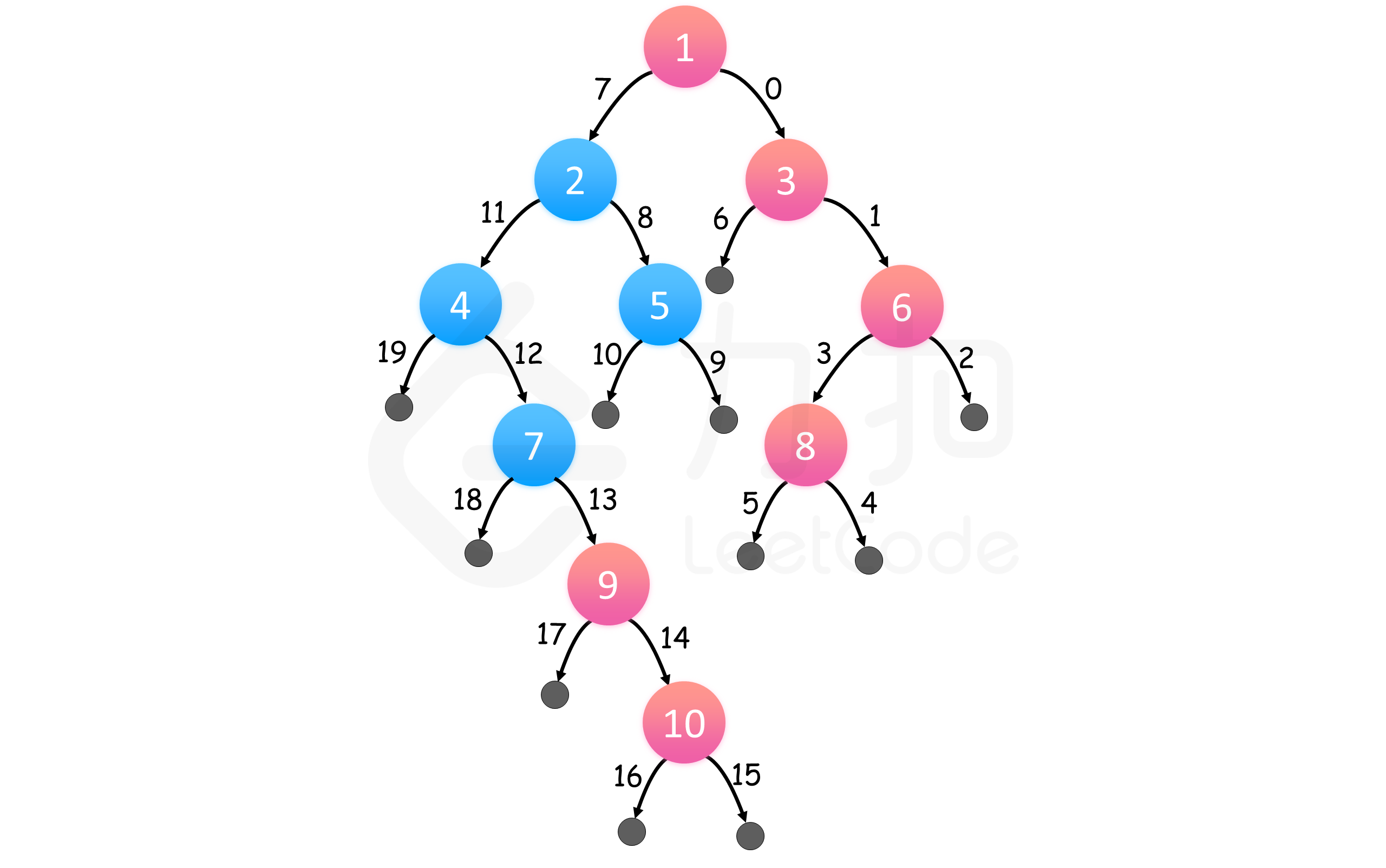
/**
* Definition for a binary tree node.
* public class TreeNode {
* int val;
* TreeNode left;
* TreeNode right;
* TreeNode() {}
* TreeNode(int val) { this.val = val; }
* TreeNode(int val, TreeNode left, TreeNode right) {
* this.val = val;
* this.left = left;
* this.right = right;
* }
* }
*/
class Solution {
public List<Integer> rightSideView(TreeNode root) {
ArrayList<Integer> res = new ArrayList<>();
if (root == null) return res;
Queue<TreeNode> queue = new ArrayDeque<>();
queue.add(root);
while(!queue.isEmpty()) {
int levelSize = queue.size();
for (int i = 1; i <= levelSize; i++) {
TreeNode node = queue.poll();
// 将左孩子入队
if (node.left != null) queue.add(node.left);
// 将右孩子结点入队
if (node.right != null) queue.add(node.right);
// 只需要将每层的最后一个放到res即可
if (i == levelSize) res.add(node.val);
}
}
return res;
}
}
637. 二叉树的层平均值
给定一个非空二叉树的根节点 root , 以数组的形式返回每一层节点的平均值。与实际答案相差 10-5 以内的答案可以被接受。
示例 1:
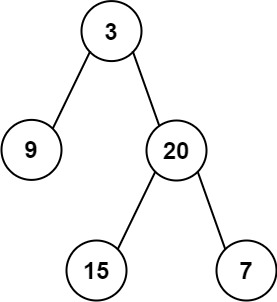
输入:root = [3,9,20,null,null,15,7]
输出:[3.00000,14.50000,11.00000]
解释:第 0 层的平均值为 3,第 1 层的平均值为 14.5,第 2 层的平均值为 11 。
因此返回 [3, 14.5, 11] 。
示例 2:
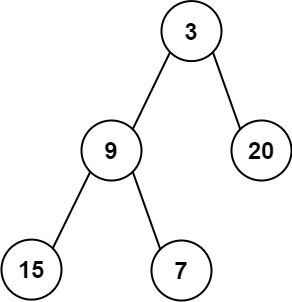
输入:root = [3,9,20,15,7]
输出:[3.00000,14.50000,11.00000]
提示:
- 树中节点数量在
[1, 104]范围内 -231 <= Node.val <= 231 - 1
思路分析
遍历每层结点时,累加结点的值,每一层累加完求平均值即可
/**
* Definition for a binary tree node.
* public class TreeNode {
* int val;
* TreeNode left;
* TreeNode right;
* TreeNode() {}
* TreeNode(int val) { this.val = val; }
* TreeNode(int val, TreeNode left, TreeNode right) {
* this.val = val;
* this.left = left;
* this.right = right;
* }
* }
*/
class Solution {
public List<Double> averageOfLevels(TreeNode root) {
ArrayList<Double> res = new ArrayList<>();
if (root == null) return res;
ArrayDeque<TreeNode> queue = new ArrayDeque<>();
queue.add(root);
while(!queue.isEmpty()) {
int levelSize = queue.size();
double sum = 0;
for (int i = 0; i < levelSize; i++) {
TreeNode node = queue.pop();
sum += node.val;
if (node.left != null) queue.add(node.left);
if (node.right != null) queue.add(node.right);
}
res.add(sum/levelSize);
}
return res;
}
}
429. N 叉树的层序遍历
给定一个 N 叉树,返回其节点值的层序遍历。(即从左到右,逐层遍历)。
树的序列化输入是用层序遍历,每组子节点都由 null 值分隔(参见示例)。
示例 1:
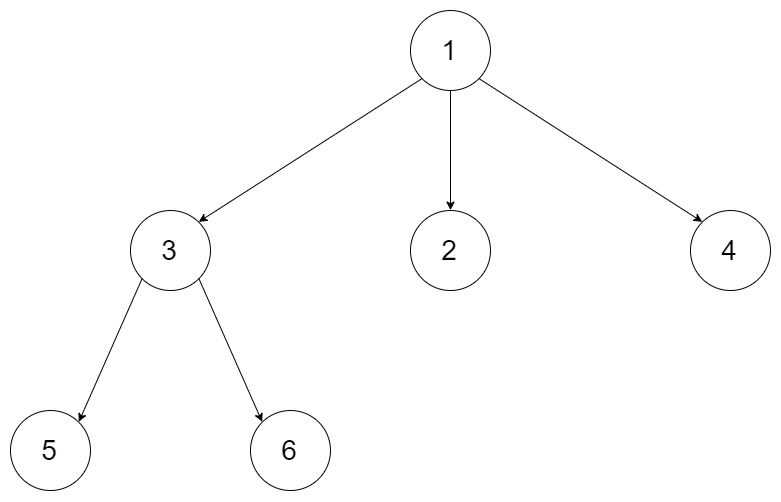
输入:root = [1,null,3,2,4,null,5,6]
输出:[[1],[3,2,4],[5,6]]
示例 2:
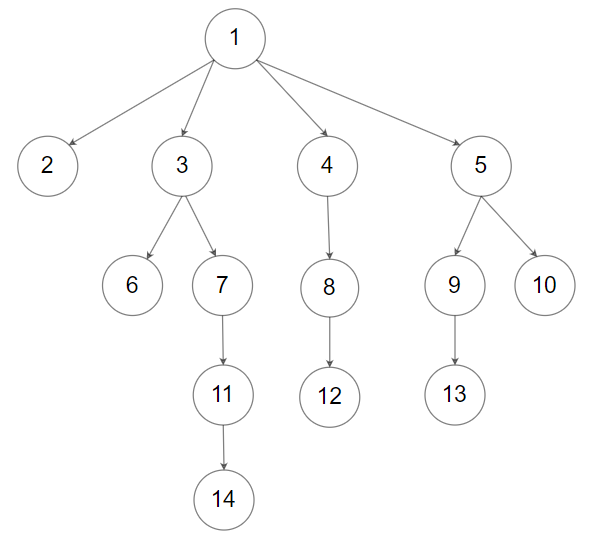
输入:root = [1,null,2,3,4,5,null,null,6,7,null,8,null,9,10,null,null,11,null,12,null,13,null,null,14]
输出:[[1],[2,3,4,5],[6,7,8,9,10],[11,12,13],[14]]
提示:
- 树的高度不会超过
1000 - 树的节点总数在
[0, 10^4]之间
思路分析
在进行二叉树遍历时,我们是将左孩子、右孩子结点入队,N叉树我们只需要改变入队规则,将 结点的 children 入队即可
/*
// Definition for a Node.
class Node {
public int val;
public List<Node> children;
public Node() {}
public Node(int _val) {
val = _val;
}
public Node(int _val, List<Node> _children) {
val = _val;
children = _children;
}
};
*/
class Solution {
public List<List<Integer>> levelOrder(Node root) {
List<List<Integer>> res = new ArrayList<>();
if (root == null) return res;
Queue<Node> queue = new ArrayDeque<>();
queue.add(root);
while(!queue.isEmpty()) {
int levelSize = queue.size();
ArrayList<Integer> item = new ArrayList<>();
for (int i = 0; i < levelSize; i++) {
Node node = queue.poll();
item.add(node.val);
// 改变入队方式
if (node.children != null){
queue.addAll(node.children);
}
}
res.add(item);
}
return res;
}
}
515. 在每个树行中找最大值
给定一棵二叉树的根节点 root ,请找出该二叉树中每一层的最大值。
示例1:
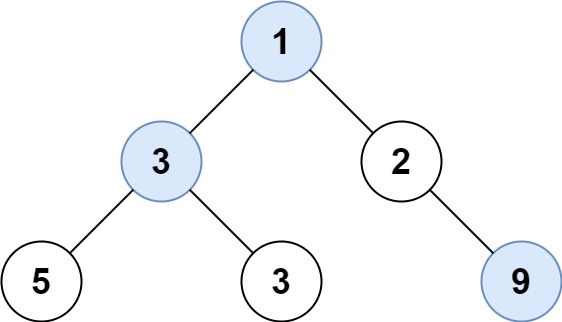
输入: root = [1,3,2,5,3,null,9]
输出: [1,3,9]
示例2:
输入: root = [1,2,3]
输出: [1,3]
提示:
- 二叉树的节点个数的范围是
[0,104] -231 <= Node.val <= 231 - 1
思路分析
没啥好分析的,和求平均值一样
/**
* Definition for a binary tree node.
* public class TreeNode {
* int val;
* TreeNode left;
* TreeNode right;
* TreeNode() {}
* TreeNode(int val) { this.val = val; }
* TreeNode(int val, TreeNode left, TreeNode right) {
* this.val = val;
* this.left = left;
* this.right = right;
* }
* }
*/
class Solution {
public List<Integer> largestValues(TreeNode root) {
ArrayList<Integer> res = new ArrayList<>();
if (root == null) return res;
Queue<TreeNode> queue = new ArrayDeque<>();
queue.add(root);
while(!queue.isEmpty()) {
int levelSize = queue.size();
int maxValue = Integer.MIN_VALUE;
for (int i = 0; i < levelSize; i++) {
TreeNode node = queue.poll();
maxValue = Math.max(maxValue,node.val);
if (node.left!=null) queue.add(node.left);
if (node.right!=null) queue.add(node.right);
}
res.add(maxValue);
}
return res;
}
}
116. 填充每个节点的下一个右侧节点指针
给定一个 完美二叉树 ,其所有叶子节点都在同一层,每个父节点都有两个子节点。二叉树定义如下:
struct Node {
int val;
Node *left;
Node *right;
Node *next;
}
填充它的每个 next 指针,让这个指针指向其下一个右侧节点。如果找不到下一个右侧节点,则将 next 指针设置为 NULL。
初始状态下,所有 next 指针都被设置为 NULL。
示例 1:

输入:root = [1,2,3,4,5,6,7]
输出:[1,#,2,3,#,4,5,6,7,#]
解释:给定二叉树如图 A 所示,你的函数应该填充它的每个 next 指针,以指向其下一个右侧节点,如图 B 所示。序列化的输出按层序遍历排列,同一层节点由 next 指针连接,'#' 标志着每一层的结束。
示例 2:
输入:root = []
输出:[]
提示:
- 树中节点的数量在
[0, 212 - 1]范围内 -1000 <= node.val <= 1000
进阶:
- 你只能使用常量级额外空间。
- 使用递归解题也符合要求,本题中递归程序占用的栈空间不算做额外的空间复杂度。
思路分析
只需要将每一层 poll 出来的结点:
- 如果下一个结点不为空,则指向下一个结点
- 如果下一个结点为空,则置为null
/*
// Definition for a Node.
class Node {
public int val;
public Node left;
public Node right;
public Node next;
public Node() {}
public Node(int _val) {
val = _val;
}
public Node(int _val, Node _left, Node _right, Node _next) {
val = _val;
left = _left;
right = _right;
next = _next;
}
};
*/
class Solution {
public Node connect(Node root) {
if (root == null) return root;
Queue<Node> queue = new ArrayDeque<Node>();
queue.add(root);
while (!queue.isEmpty()) {
int levelSize = queue.size();
for (int i = 0; i < levelSize; i++) {
// 当前层的第一个节点
Node node = queue.poll();
// 当前节点的下一个节点,当前结点为这一层的最后一个节点,则为null
node.next = (i == levelSize - 1) ? null : queue.peek();
if (node.left != null) queue.add(node.left);
if (node.right != null) queue.add(node.right);
}
}
return root;
}
}
104. 二叉树的最大深度
给定一个二叉树 root ,返回其最大深度。
二叉树的 最大深度 是指从根节点到最远叶子节点的最长路径上的节点数。
示例 1:
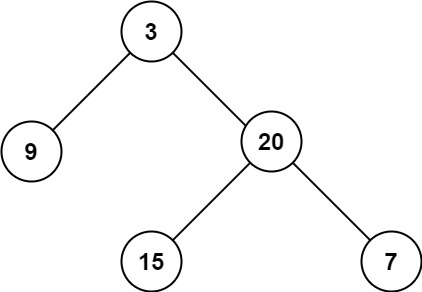
输入:root = [3,9,20,null,null,15,7]
输出:3
示例 2:
输入:root = [1,null,2]
输出:2
提示:
- 树中节点的数量在
[0, 104]区间内。 -100 <= Node.val <= 100
思路分析
在遍历完每一层时,用一个变量进行累加
/**
* Definition for a binary tree node.
* public class TreeNode {
* int val;
* TreeNode left;
* TreeNode right;
* TreeNode() {}
* TreeNode(int val) { this.val = val; }
* TreeNode(int val, TreeNode left, TreeNode right) {
* this.val = val;
* this.left = left;
* this.right = right;
* }
* }
*/
class Solution {
public int maxDepth(TreeNode root) {
if (root == null) return 0;
ArrayDeque<TreeNode> queue = new ArrayDeque<>();
queue.add(root);
// 记录最大深度
int max = 0;
while (!queue.isEmpty()) {
int size = queue.size();
for (int i = 0; i < size; i++) {
TreeNode node = queue.poll();
if (node.left!= null) queue.add(node.left);
if (node.right!= null) queue.add(node.right);
}
max++;
}
return max;
}
}
111. 二叉树的最小深度
给定一个二叉树,找出其最小深度。
最小深度是从根节点到最近叶子节点的最短路径上的节点数量。
**说明:**叶子节点是指没有子节点的节点。
示例 1:
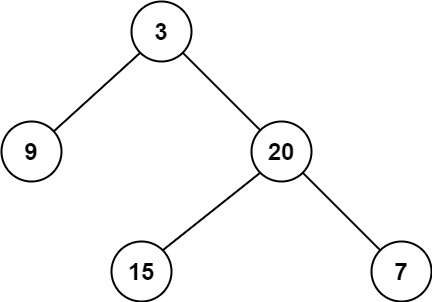
输入:root = [3,9,20,null,null,15,7]
输出:2
示例 2:
输入:root = [2,null,3,null,4,null,5,null,6]
输出:5
提示:
- 树中节点数的范围在
[0, 105]内 -1000 <= Node.val <= 1000
思路分析
相较于最大深度,最小深度是 当某个结点的左右子树都为空时,此时就达到了最近的叶子结点,直接返回深度即可。
/**
* Definition for a binary tree node.
* public class TreeNode {
* int val;
* TreeNode left;
* TreeNode right;
* TreeNode() {}
* TreeNode(int val) { this.val = val; }
* TreeNode(int val, TreeNode left, TreeNode right) {
* this.val = val;
* this.left = left;
* this.right = right;
* }
* }
*/
class Solution {
public int minDepth(TreeNode root) {
if (root == null) return 0;
ArrayDeque<TreeNode> queue = new ArrayDeque<>();
queue.add(root);
int level = 1;
while (!queue.isEmpty()) {
int size = queue.size();
for (int i = 0; i < size; i++) {
TreeNode node = queue.poll();
// 当左右子树都为空时,说明到达叶子节点,返回当前层数
if (node.left == null && node.right == null) {
return level;
}
if (node.left != null) {
queue.add(node.left);
}
if (node.right != null) {
queue.add(node.right);
}
}
level++;
}
return level;
}
}
总结
二叉树的层序遍历有俩种思想: 一种是 bfs(广度优先遍历)、一种是 dfs(深度优先遍历),其中层序遍历使用 bfs 更简单,其模板:
void bfs(TreeNode root) {
Queue<TreeNode> queue = new ArrayDeque<>();
queue.add(root);
while (!queue.isEmpty()) {
TreeNode node = queue.poll(); // Java 的 pop 写作 poll()
if (node.left != null) {
queue.add(node.left);
}
if (node.right != null) {
queue.add(node.right);
}
}
}
226. 翻转二叉树
给你一棵二叉树的根节点 root ,翻转这棵二叉树,并返回其根节点。
示例 1:

输入:root = [4,2,7,1,3,6,9]
输出:[4,7,2,9,6,3,1]
示例 2:

输入:root = [2,1,3]
输出:[2,3,1]
示例 3:
输入:root = []
输出:[]
提示:
- 树中节点数目范围在
[0, 100]内 -100 <= Node.val <= 100
思路分析
通过题目描述中也可以得知,所谓的翻转,其实就是将每一层的左右孩子结点进行交换即可。
先序、后序、层序遍历均可以实现,为什么没有中序呢?中序其实也可以,但是需要考虑的是,在遍历结点的过程中,可能会交换俩次。
递归:先序遍历
/**
* Definition for a binary tree node.
* public class TreeNode {
* int val;
* TreeNode left;
* TreeNode right;
* TreeNode() {}
* TreeNode(int val) { this.val = val; }
* TreeNode(int val, TreeNode left, TreeNode right) {
* this.val = val;
* this.left = left;
* this.right = right;
* }
* }
*/
class Solution {
public TreeNode invertTree(TreeNode root) {
if (root == null) return root;
// 交换
swap(root);
// 遍历左子树
invertTree(root.left);
// 遍历右子树
invertTree(root.right);
return root;
}
// 交换左右孩子结点
public void swap(TreeNode node) {
if (node == null) return;
TreeNode temp = node.left;
node.left = node.right;
node.right = temp;
}
}
bfs - 层序遍历
/**
* Definition for a binary tree node.
* public class TreeNode {
* int val;
* TreeNode left;
* TreeNode right;
* TreeNode() {}
* TreeNode(int val) { this.val = val; }
* TreeNode(int val, TreeNode left, TreeNode right) {
* this.val = val;
* this.left = left;
* this.right = right;
* }
* }
*/
class Solution {
public TreeNode invertTree(TreeNode root) {
if (root == null) return root;
Queue<TreeNode> queue = new ArrayDeque<>();
queue.add(root);
while(!queue.isEmpty()) {
TreeNode node = queue.poll();
// 左右交换
swap(node);
if (node.left!= null) queue.add(node.left);
if (node.right!= null) queue.add(node.right);
}
return root;
}
}
101. 对称二叉树
给你一个二叉树的根节点 root , 检查它是否轴对称。
示例 1:
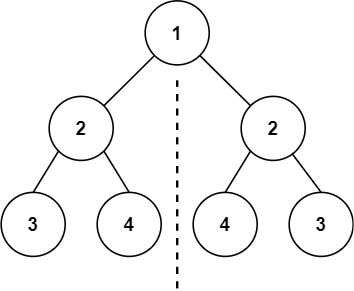
输入:root = [1,2,2,3,4,4,3]
输出:true
示例 2:
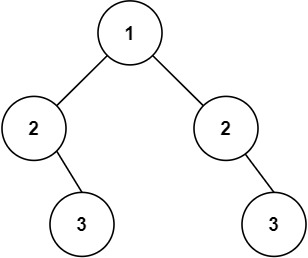
输入:root = [1,2,2,null,3,null,3]
输出:false
提示:
- 树中节点数目在范围
[1, 1000]内 -100 <= Node.val <= 100
**进阶:**你可以运用递归和迭代两种方法解决这个问题吗?
思路分析
首先要思考一颗对称的二叉树他有什么特点,根据下图来说:
- 俩颗对称的子树它的根的值是相等的
- 俩颗子树互为镜像。(这句话怎么理解呢?)
- 左子树的左节点和右子树的右结点是相等的
- 左子树的右结点和右子树的左节点是相等的
- 即:$left.left = right.right , left.right = right.left$
只要满足以上几种情况,就可以说明该二叉树是对称的,否则则不是。我们也可以利用这些条件做题。
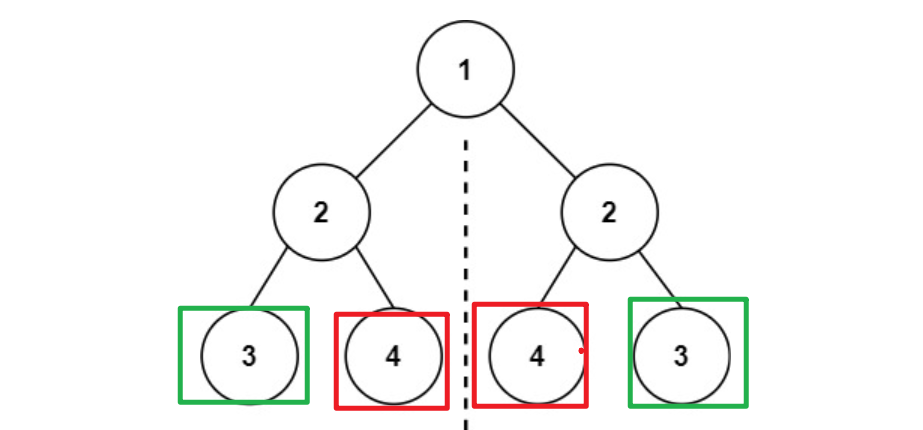
第一种方法:递归
- 终止条件就是上面说的那几种情况,只要不满足就返回false
- 根结点值不相等,返回false
- 左子树或者右子树有一个为空,返回 false
- 左子树和右子树都为空,返回true(说明已经没有结点了,也没有返回false)
- 每次递归的元素为:左子树的左节点和右子树的右结点,左子树的右结点和右子树的左节点
public boolean isSymmetric2(TreeNode root) {
if (root == null) return true;
return recursive(root.left, root.right);
}
private boolean recursive(TreeNode left, TreeNode right) {
// 如果两个结点都为空,那么就对称的
if (left == null && right == null) return true;
// 如果有一个结点为空,那么就是不对称的
if (left == null || right == null) return false;
// 根结点的值不相等,那么就不是对称的
if (left.val != right.val) return false;
// 递归比较左右子树
return recursive(left.left,right.right) && recursive(left.right,right.left);
}
第二种方法:迭代
将递归的比较换成队列,先将左右子树入队,然后继续根据上面的三个条件进行比较。
将 left.left、right.right 入队,left.right、right.left 入队
public boolean isSymmetric1(TreeNode root) {
// 如果只有一个结点,那么一定是对称的
if (root == null || (root.left == null && root.right == null)) return true;
LinkedList<TreeNode> queue = new LinkedList<>();
queue.add(root.left);
queue.add(root.right);
while (queue.size() > 0) {
// 取出俩个结点,比较它们的值
TreeNode left = queue.poll();
TreeNode right = queue.poll();
if (left == null && right == null) continue;
// 如果其中一个结点为空,另一个不为空,那么就不是对称的
if (left == null || right == null) return false;
// 如果两个结点的值不相等,那么就不是对称的
if (left.val != right.val) return false;
// 比较左子树的左孩子结点和右子树的右孩子结点
queue.add(left.left);
queue.add(right.right);
// 比较左子树的右孩子结点和右子树的左孩子结点
queue.add(left.right);
queue.add(right.left);
}
// 如果循环结束,那么说明所有的结点都比较完了,那么就是对称的
return true;
}
222. 完全二叉树的节点个数
给你一棵 完全二叉树 的根节点 root ,求出该树的节点个数。
完全二叉树 的定义如下:在完全二叉树中,除了最底层节点可能没填满外,其余每层节点数都达到最大值,并且最下面一层的节点都集中在该层最左边的若干位置。若最底层为第 h 层,则该层包含 1~ 2h 个节点。
示例 1:
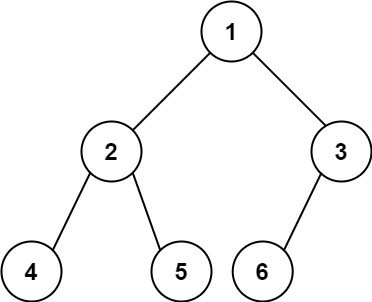
输入:root = [1,2,3,4,5,6]
输出:6
示例 2:
输入:root = []
输出:0
示例 3:
输入:root = [1]
输出:1
提示:
- 树中节点的数目范围是
[0, 5 * 104] 0 <= Node.val <= 5 * 104- 题目数据保证输入的树是 完全二叉树
思路分析
使用 dfs 和 bfs 都可以
dfs:
/**
* Definition for a binary tree node.
* public class TreeNode {
* int val;
* TreeNode left;
* TreeNode right;
* TreeNode() {}
* TreeNode(int val) { this.val = val; }
* TreeNode(int val, TreeNode left, TreeNode right) {
* this.val = val;
* this.left = left;
* this.right = right;
* }
* }
*/
class Solution {
public int countNodes(TreeNode root) {
if (root == null) return 0;
// 左子树结点+右子树结点+根节点
return countNodes(root.left) + countNodes(root.right) + 1;
}
}
bfs:
public int countNodes(TreeNode root) {
if (root == null) return 0;
ArrayDeque<TreeNode> queue = new ArrayDeque<>();
int sum = 0;
queue.add(root);
while(!queue.isEmpty()) {
int size = queue.size();
for (int i = 0; i < size; i++) {
TreeNode node = queue.pop();
sum+=1;
if (node.left != null) queue.add(node.left);
if (node.right != null) queue.add(node.right);
}
}
return sum;
}
110. 平衡二叉树
给定一个二叉树,判断它是否是高度平衡的二叉树。
本题中,一棵高度平衡二叉树定义为:
一个二叉树每个节点 的左右两个子树的高度差的绝对值不超过 1 。
示例 1:
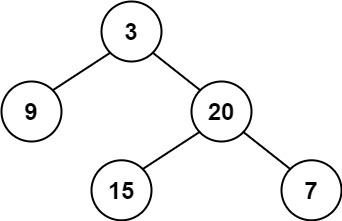
输入:root = [3,9,20,null,null,15,7]
输出:true
示例 2:
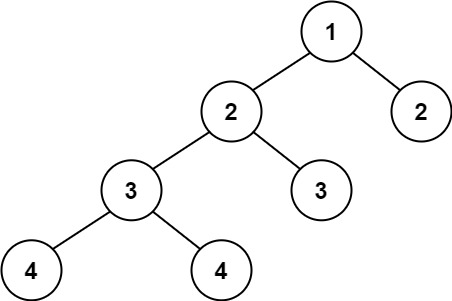
输入:root = [1,2,2,3,3,null,null,4,4]
输出:false
示例 3:
输入:root = []
输出:true
提示:
- 树中的节点数在范围
[0, 5000]内 -104 <= Node.val <= 104
思路分析
平衡二叉树的定义:$一个二叉树 每个节点 的左右两个子树的高度差的绝对值不超过 1 $。
对于一颗平衡二叉树来说,他所有的子树均为二叉树,因此我们可以使用递归判断所有的子树是否为二叉树
有俩种递归方式,一种是自上而下,另一种是自下而上
方法一:自上而下
自上而下类似与前序遍历,对每一颗子树都进行判断是否是平衡二叉树
public boolean isBalanced(TreeNode root) {
if (root == null) return true;
return Math.abs(height(root.left) - height((root.right))) <= 1 && isBalanced(root.right) && isBalanced(root.left);
}
// 求出二叉树的最大深度(先序遍历)
public int height(TreeNode node){
if (node == null) return 0;
return Math.max(height(node.left) , height(node.right)) + 1;
}
方法二: 自下而上
类似于后序遍历,以该结点为根节点的二叉树是平衡二叉树则返回最大 高度,若不是返回-1.
相较于自上而下来说,这种方法对于每个结点只会处理一次,而自上而下需要处理该结点下的每颗子树。
/**
* Definition for a binary tree node.
* public class TreeNode {
* int val;
* TreeNode left;
* TreeNode right;
* TreeNode() {}
* TreeNode(int val) { this.val = val; }
* TreeNode(int val, TreeNode left, TreeNode right) {
* this.val = val;
* this.left = left;
* this.right = right;
* }
* }
*/
class Solution {
public boolean isBalanced(TreeNode root) {
return height1(root) >=0;
}
public int height1(TreeNode node) {
if (node == null) return 0;
int left = height1(node.left);
int right = height1(node.right);
// 如果左右子树的高度差大于1,则返回-1
if (left == -1 || right == -1 || Math.abs(left - right) > 1) {
return -1;
} else {
// 否则返回高度
return Math.max(left , right) + 1;
}
}
}
☆ 257. 二叉树的所有路径
给你一个二叉树的根节点 root ,按 任意顺序 ,返回所有从根节点到叶子节点的路径。
叶子节点 是指没有子节点的节点。
示例 1:
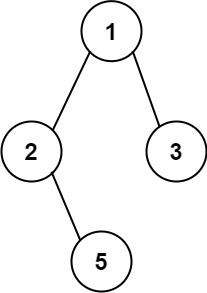
输入:root = [1,2,3,null,5]
输出:["1->2->5","1->3"]
示例 2:
输入:root = [1]
输出:["1"]
提示:
- 树中节点的数目在范围
[1, 100]内 -100 <= Node.val <= 100
思路分析
通过题意我们很清楚的知道使用先序遍历 + 回溯方法。当我们将一条路径存到集合中,我们需要回溯到初始结点,继续找下一条路径!
先序遍历的方法有: 递归、迭代,也可以使用bfs层序遍历实现!
1、递归
递归版本的先序遍历代码如下
public void dfs(TreeNode node){
if (node == null) return;
System.out.println(node.val);
dfs(node.left);
dfs(node.right);
}
我们可以依据上面为模板进行改良,此时不再是输出结点,而是将叶子结点的路径保存起来,代码如下:
可能会有疑问?这也没进行回溯啊?其实是有的,回溯隐藏在在每次递归的时候。即:$path + node.val + "->"$
class Solution {
public List<String> binaryTreePaths(TreeNode root) {
ArrayList<String> res = new ArrayList<>();
dfs(root, "", res);
return res;
}
public void dfs(TreeNode node, String path, List<String> res) {
if (node == null) return;
if (node.left == null && node.right == null) {
// 该结点为叶子结点
res.add(path + node.val);
return;
}
// 在每次遍历的过程中,都要将当前结点的值添加到路径中,这也是隐藏的回溯
dfs(node.left, path + node.val + "->", res);
dfs(node.right , path + node.val + "->", res);
}
}
2、非递归
先看一下非递归的先序遍历代码,如下:
public void iterator(TreeNode root) {
if (root == null) return;
Stack<TreeNode> stack = new Stack<>();
stack.push(root);
while(!stack.isEmpty()){
TreeNode node = stack.pop();
System.out.println(node.val);
if (node.right != null) stack.push(node.right);
if (node.left != null) stack.push(node.left);
}
}
同样我们也可以对以上代码进行改良,但此时我们需要注意使用迭代的方式,注意进行回溯,递归与回溯一一对应,每一次递归(入栈) 都要进行一次回溯!
public List<String> iterator(TreeNode root) {
ArrayList<String> res = new ArrayList<>();
if (root == null) return res;
// 在这里,路径和结点是成双成对的,,保存路径的栈和保存结点的栈使用一个栈来实现
Stack<Object> stack = new Stack<>();
stack.push(root.val + "");
stack.push(root);
while (!stack.isEmpty()) {
// 注意push、pop的时机,都是先push路径,在push结点。先弹出来的是结点,后是路径
TreeNode node = (TreeNode) stack.pop();
String path = (String) stack.pop();
// 如果是叶子结点,保存路径
if (node.left == null && node.right == null) res.add(path);
if (node.right != null) {
// 每进行一次入栈,都要进行一次回溯
stack.push(path + "->" + node.right.val);
stack.push(node.right);
}
;
if (node.left != null) {
stack.push(path + "->" + node.left.val);
stack.push(node.left);
}
;
}
return res;
}
3、bfs层序遍历
同样,先看层序遍历代码模板:
public void sequence(TreeNode root) {
if (root == null) return;
Queue<TreeNode> queue = new ArrayDeque<>();
queue.add(root);
while (!queue.isEmpty()) {
TreeNode node = queue.poll();
System.out.println(node.val);
if (node.left != null) queue.add(node.left);
if (node.right != null) queue.add(node.right);
}
}
改进思路和第二种方法 一样,也是要注意回溯的时机
public List<String> sequence(TreeNode root) {
ArrayList<String> res = new ArrayList<>();
if (root == null) return res;
Queue<Object> queue = new ArrayDeque<>();
queue.add(root.val + "");
queue.add(root);
while (!queue.isEmpty()) {
String path = (String)queue.poll();
TreeNode node = (TreeNode) queue.poll();
if (node.left==null && node.right==null) res.add(path);
if (node.left != null) {
queue.add(path + "->" + node.left.val);
queue.add(node.left);
};
if (node.right != null) {
queue.add(path + "->" + node.right.val);
queue.add(node.right);
};
}
return res;
}
404. 左叶子之和
给定二叉树的根节点 root ,返回所有左叶子之和。
示例 1:
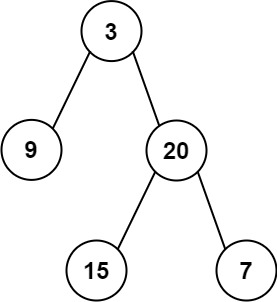
输入: root = [3,9,20,null,null,15,7]
输出: 24
解释: 在这个二叉树中,有两个左叶子,分别是 9 和 15,所以返回 24
示例 2:
输入: root = [1]
输出: 0
提示:
- 节点数在
[1, 1000]范围内 -1000 <= Node.val <= 1000
思路分析
当某个结点没有左右孩子结点,该结点就是叶子结点。
我们可以使用 dfs 和 bfs 俩种方法,即递归或者迭代。
在遍历过程中,我们只需要判断它的左子节点是否有左右孩子结点,如果没有就是叶子结点,累加左子节点的值即可。
dfs:
class Solution {
// 先序遍历-递归
int sum = 0;
public int sumOfLeftLeaves(TreeNode root) {
dfs(root);
return sum;
}
public void dfs(TreeNode node) {
if (node == null) return;
// 左叶子节点
if (node.left != null && node.left.left == null && node.left.right == null){
sum += node.left.val;
}
dfs(node.left);
dfs(node.right);
}
}
bfs:
class Solution {
public int sumOfLeftLeaves(TreeNode root) {
if (root == null) return 0;
int sum = 0;
Stack<TreeNode> stack = new Stack<>();
stack.push(root);
while(!stack.isEmpty()) {
TreeNode node = stack.pop();
if (node.left!= null){
if (node.left.left == null && node.left.right == null) {
// 说明是叶子节点
sum += node.left.val;
}else{
stack.push(node.left);
}
}
if (node.right != null) stack.push(node.right);
}
return sum;
}
}
513. 找树左下角的值
给定一个二叉树的 根节点 root,请找出该二叉树的 最底层 最左边 节点的值。
假设二叉树中至少有一个节点。
示例 1:
输入: root = [2,1,3]
输出: 1
示例 2:
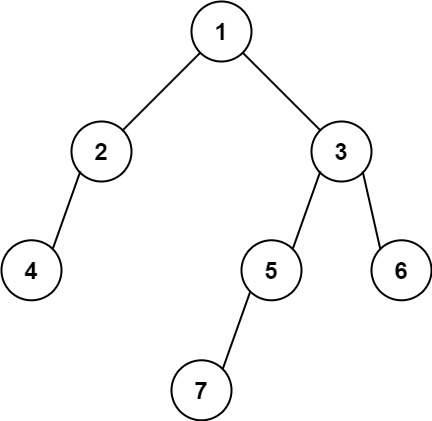
输入: [1,2,3,4,null,5,6,null,null,7]
输出: 7
提示:
- 二叉树的节点个数的范围是
[1,104] -231 <= Node.val <= 231 - 1
思路分析
题目要求找到最后一层最左边的结点,我的第一想法是:
1、求出二叉树的高度
2、进行层序遍历,找出最后一层的第一个结点,该结点为最左侧的结点
代码如下:
public int findBottomLeftValue(TreeNode root) {
if (root == null) return 0;
Queue<TreeNode> queue = new ArrayDeque<>();
queue.add(root);
int height = getHeight(root);
while(!queue.isEmpty()) {
int levelSize = queue.size();
height--;
for (int i = 0; i < levelSize; i++) {
TreeNode node = queue.poll();
if (node.left!= null) queue.add(node.left);
if (node.right!= null) queue.add(node.right);
// 判断该结点是否为最后一层最左边的
if (height == 0) return node.val;
}
}
return 0;
}
// 获取二叉树的高度
public int getHeight(TreeNode node) {
if (node == null) return 0;
return Math.max(getHeight(node.left), getHeight(node.right)) + 1;
}
随后又仔细想了一下,我直接从右向左层序遍历,最后一个结点不就是最左侧的结点吗? 好一个脱裤子放屁!!
改良后的代码:
// 层序遍历————从右往左,最后一个访问的就是最左侧的结点
public int findBottomLeftValue1(TreeNode root) {
if (root == null) return 0;
Queue<TreeNode> queue = new ArrayDeque<>();
queue.add(root);
int res = 0;
while(!queue.isEmpty()) {
TreeNode node = queue.poll();
res = node.val;
if (node.right != null) queue.add(node.right);
if (node.left != null) queue.add(node.left);
}
return res;
}
112. 路径总和
给你二叉树的根节点 root 和一个表示目标和的整数 targetSum 。判断该树中是否存在 根节点到叶子节点 的路径,这条路径上所有节点值相加等于目标和 targetSum 。如果存在,返回 true ;否则,返回 false 。
叶子节点 是指没有子节点的节点。
示例 1:
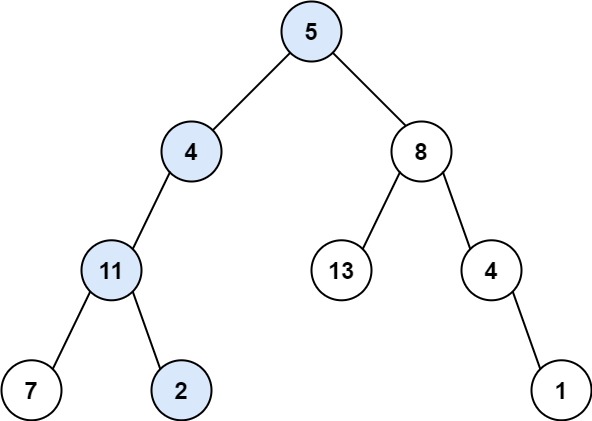
输入:root = [5,4,8,11,null,13,4,7,2,null,null,null,1], targetSum = 22
输出:true
解释:等于目标和的根节点到叶节点路径如上图所示。
示例 2:
输入:root = [1,2,3], targetSum = 5
输出:false
解释:树中存在两条根节点到叶子节点的路径:
(1 --> 2): 和为 3
(1 --> 3): 和为 4
不存在 sum = 5 的根节点到叶子节点的路径。
示例 3:
输入:root = [], targetSum = 0
输出:false
解释:由于树是空的,所以不存在根节点到叶子节点的路径。
提示:
- 树中节点的数目在范围
[0, 5000]内 -1000 <= Node.val <= 1000-1000 <= targetSum <= 1000
思路分析
这道题和 257. 二叉树的所有路径 思路一样,都需要进行回溯,只不过该题回溯的是 结点的和!
1、递归
回溯隐藏在递归中,targetSum - root.val
public boolean hasPathSum(TreeNode root, int targetSum) {
if (root == null) return false;
if (root.left == null && root.right == null) return targetSum - root.val == 0;
// 递归+回溯
return hasPathSum(root.left,targetSum - root.val) || hasPathSum(root.right,targetSum - root.val) ;
}
2、非递归
public boolean hasPathSum(TreeNode root, int targetSum) {
if (root == null) return false;
// 即保存结点也保存结点和
Stack<Object> stack = new Stack<>();
stack.push(root.val);
stack.push(root);
while (!stack.isEmpty()) {
TreeNode node = (TreeNode) stack.pop();
Integer sum = (Integer) stack.pop();
// 如果sum和等于targetSum并且该结点为叶子结点 直接返回true
if (sum == targetSum && node.left == null && node.right == null) return true;
// 每次入栈都要伴随着一次回溯
if (node.left != null) {
stack.push(sum + node.left.val);
stack.push(node.left);
}
if (node.right != null) {
stack.push(sum + node.right.val);
stack.push(node.right);
}
}
return false;
}
106. 从中序与后序遍历序列构造二叉树
给定两个整数数组 inorder 和 postorder ,其中 inorder 是二叉树的中序遍历, postorder 是同一棵树的后序遍历,请你构造并返回这颗 二叉树 。
示例 1:

输入:inorder = [9,3,15,20,7], postorder = [9,15,7,20,3]
输出:[3,9,20,null,null,15,7]
示例 2:
输入:inorder = [-1], postorder = [-1]
输出:[-1]
提示:
1 <= inorder.length <= 3000postorder.length == inorder.length-3000 <= inorder[i], postorder[i] <= 3000inorder和postorder都由 不同 的值组成postorder中每一个值都在inorder中inorder保证是树的中序遍历postorder保证是树的后序遍历
思路分析
中序遍历+后续遍历确定一颗二叉树步骤:
1、找出根节点: 由于后续遍历根节点总是在最后遍历,因此postorder 数组最后一个元素为根结点
2、确定根节点在inorder 中的位置: 中序遍历中根结点在中间,左边为左子树,右边为右子树
3、确定根节点的左子树的起始范围
4、确定根节点的右子树的起始范围
不断重复上面的四步,直到构成一个二叉树!
其实构建二叉树的步骤大家都明白,只是在递归的过程中,左右子树的起始范围不太好确定, 看一下下面这张图:
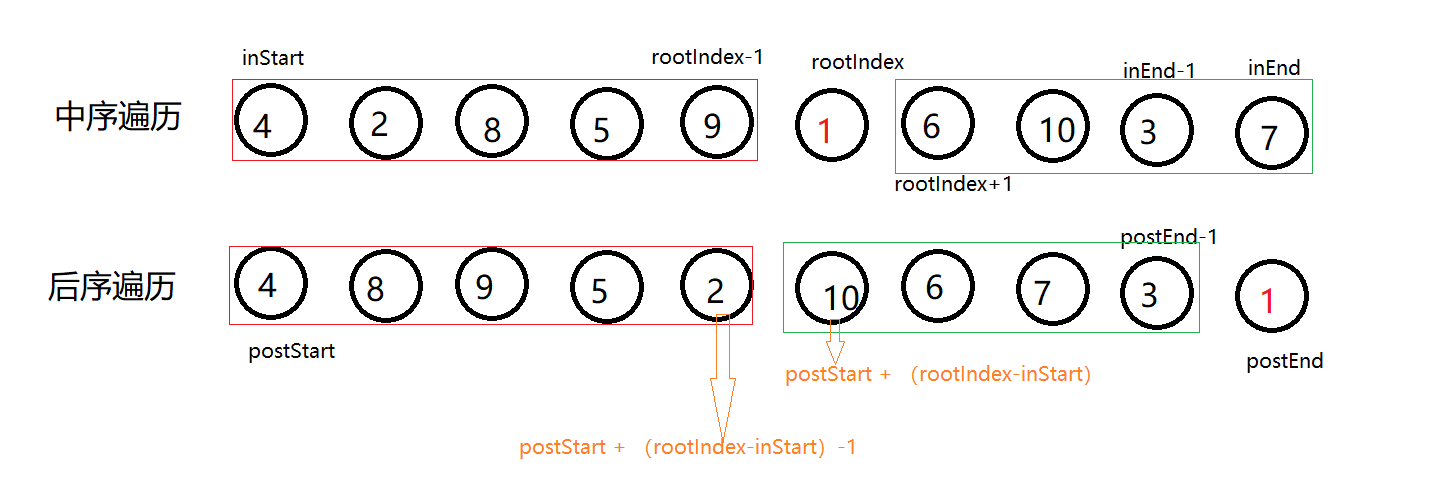
疑问点:
$rootIndex - inStart $是什么?
通过图片其实可以看出,$rootIndex - inStart $ 得到的是根结点左子树的个数 ,无论是中序、后续,它的左右子树结点个数肯定是不会变的。
// 保存中序遍历的值与下标对应关系
HashMap<Integer, Integer> map = new HashMap<Integer, Integer>();
public TreeNode buildTree1(int[] inorder, int[] postorder) {
for (int i = 0; i < inorder.length; i++) {
map.put(inorder[i], i);
}
return helper(postorder, 0, inorder.length - 1, 0, postorder.length - 1);
}
// 递归
public TreeNode helper(int[] postorder, int inStart, int inEnd, int postStart, int postEnd) {
if (inStart > inEnd || postStart > postEnd) {
return null;
}
// 找到根结点
TreeNode root = new TreeNode(postorder[postEnd]);
// 从map中找到根结点在中序遍历中的下表
Integer rootIndex = map.get(root.val);
// 计算出中序遍历中根结点的左子树结点的个数
int nums_in_left = rootIndex - inStart;
// 递归左子树
root.left = helper(postorder, inStart, rootIndex - 1, postStart, postStart + nums_in_left - 1);
root.right = helper(postorder, rootIndex + 1, inEnd, postStart + nums_in_left, postEnd - 1);
return root;
}
105. 从前序与中序遍历序列构造二叉树
给定两个整数数组 preorder 和 inorder ,其中 preorder 是二叉树的先序遍历, inorder 是同一棵树的中序遍历,请构造二叉树并返回其根节点。
示例 1:
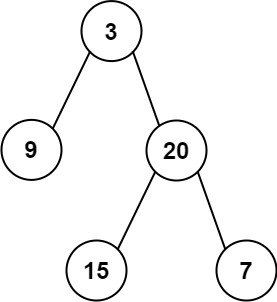
输入: preorder = [3,9,20,15,7], inorder = [9,3,15,20,7]
输出: [3,9,20,null,null,15,7]
示例 2:
输入: preorder = [-1], inorder = [-1]
输出: [-1]
提示:
1 <= preorder.length <= 3000inorder.length == preorder.length-3000 <= preorder[i], inorder[i] <= 3000preorder和inorder均 无重复 元素inorder均出现在preorderpreorder保证 为二叉树的前序遍历序列inorder保证 为二叉树的中序遍历序列
思路分析
思路其实和 106. 从中序与后序遍历序列构造二叉树 一样:
1、从前序遍历中找到根结点: 与后序遍历不同的是,根节点为前序遍历中的第一个结点
2、从中序遍历中找到根结点的位置
3、确定根结点左子树的起始范围
4、确定根结点右子树的起始范围
不断循环上面的步骤,直到构建出二叉树!
与后序遍历+中序遍历不同的是,每次循环左子树、右子树的起始范围不同,看下面这张图:
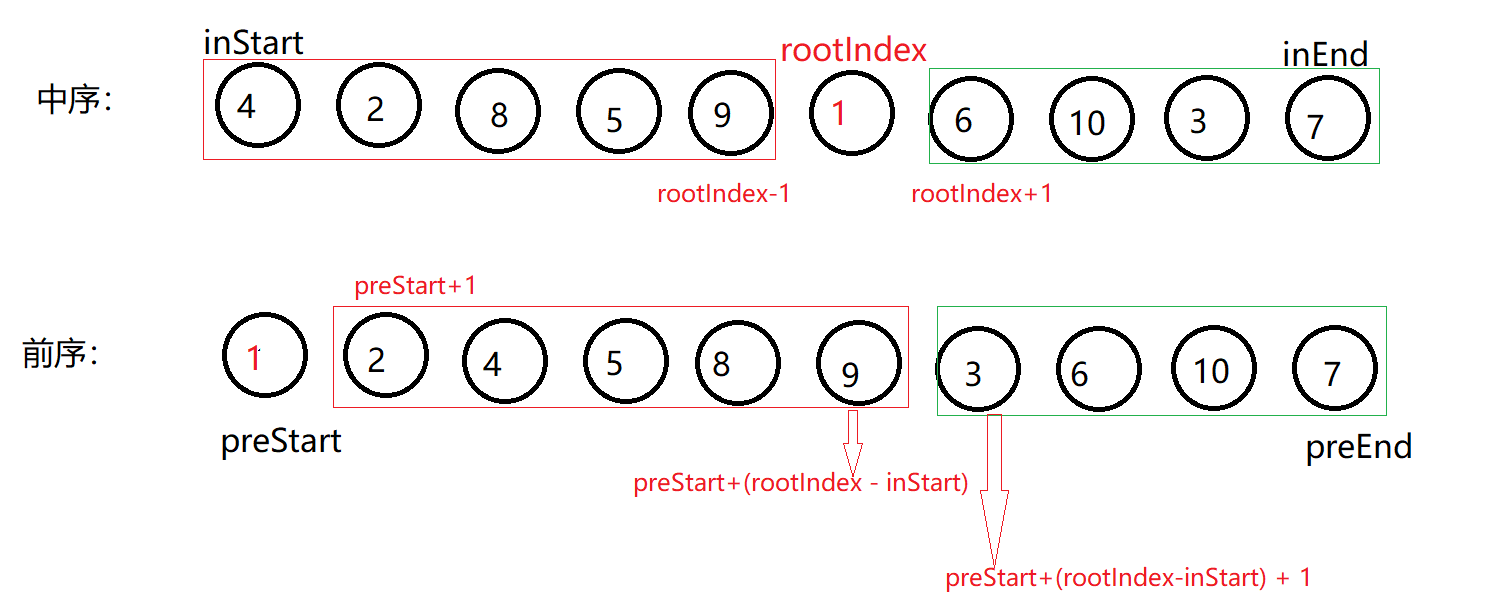
class Solution {
// 使用map保存inOrder节点值与下标的对应关系
HashMap<Integer, Integer> map = new HashMap<>();
public TreeNode buildTree(int[] preorder, int[] inorder) {
for (int i = 0; i < inorder.length; i++) {
map.put(inorder[i], i);
}
return helper(preorder, 0, preorder.length - 1, 0, inorder.length - 1);
}
public TreeNode helper(int[] preorder, int preStart, int preEnd, int inStart, int inEnd) {
// 终止条件
if (preStart > preEnd || inStart > inEnd) return null;
// 获取根节点
TreeNode root = new TreeNode(preorder[preStart]);
// 根据结点值从map中获取根节点的下标
Integer rootIndex = map.get(root.val);
// 计算根节点左子树的结点数量
Integer nums_left_nodes = rootIndex - inStart;
// 递归处理左右子树
root.left = helper(preorder, preStart + 1, preStart + nums_left_nodes, inStart, rootIndex - 1);
root.right = helper(preorder, preStart + nums_left_nodes + 1, preEnd, rootIndex + 1, inEnd);
return root;
}
}
654. 最大二叉树
给定一个不重复的整数数组 nums 。 最大二叉树 可以用下面的算法从 nums 递归地构建:
- 创建一个根节点,其值为
nums中的最大值。 - 递归地在最大值 左边 的 子数组前缀上 构建左子树。
- 递归地在最大值 右边 的 子数组后缀上 构建右子树。
返回 nums 构建的 *最大二叉树* 。
示例 1:
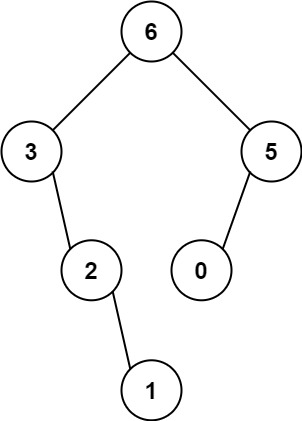
输入:nums = [3,2,1,6,0,5]
输出:[6,3,5,null,2,0,null,null,1]
解释:递归调用如下所示:
- [3,2,1,6,0,5] 中的最大值是 6 ,左边部分是 [3,2,1] ,右边部分是 [0,5] 。
- [3,2,1] 中的最大值是 3 ,左边部分是 [] ,右边部分是 [2,1] 。
- 空数组,无子节点。
- [2,1] 中的最大值是 2 ,左边部分是 [] ,右边部分是 [1] 。
- 空数组,无子节点。
- 只有一个元素,所以子节点是一个值为 1 的节点。
- [0,5] 中的最大值是 5 ,左边部分是 [0] ,右边部分是 [] 。
- 只有一个元素,所以子节点是一个值为 0 的节点。
- 空数组,无子节点。
示例 2:
输入:nums = [3,2,1]
输出:[3,null,2,null,1]
提示:
1 <= nums.length <= 10000 <= nums[i] <= 1000nums中的所有整数 互不相同
思路分析
该题和 105、106一样,只不过不再是从前序或者后序找根结点,而是找最大值。
还是要强调一点:注意搜索最大值的起始范围。我才用的左闭右开区间。
假设最大值下标为rootIndex,则左子树搜索范围:[begin,rootIndex), 右子树搜索范围: [rootIndex,end)
public TreeNode constructMaximumBinaryTree(int[] nums) {
return helper(nums, 0, nums.length);
}
public TreeNode helper(int[] nums, int begin, int end) {
// 终止条件,如果是左闭右闭区间,则是 begin>end
if (begin >= end) return null;
// 找到数组最大值的下标
int rootIndex = findMax(nums, begin, end);
// 以最大值为根结点
TreeNode root = new TreeNode(nums[rootIndex]);
// 递归找左右字数:[begin,rootIdnex) [rootIndex,end)
root.left = helper(nums, begin, rootIndex);
root.right = helper(nums, rootIndex + 1, end);
return root;
}
private static int findMax(int[] nums, int begin, int end) {
// 假设第一个元素为最大值
int max_index = begin;
for (int i = begin; i < end; i++) {
if (nums[max_index] < nums[i]) {
max_index = i;
}
}
return max_index;
}
617. 合并二叉树
给你两棵二叉树: root1 和 root2 。
想象一下,当你将其中一棵覆盖到另一棵之上时,两棵树上的一些节点将会重叠(而另一些不会)。你需要将这两棵树合并成一棵新二叉树。合并的规则是:如果两个节点重叠,那么将这两个节点的值相加作为合并后节点的新值;否则,不为 null 的节点将直接作为新二叉树的节点。
返回合并后的二叉树。
注意: 合并过程必须从两个树的根节点开始。
示例 1:

输入:root1 = [1,3,2,5], root2 = [2,1,3,null,4,null,7]
输出:[3,4,5,5,4,null,7]
示例 2:
输入:root1 = [1], root2 = [1,2]
输出:[2,2]
提示:
- 两棵树中的节点数目在范围
[0, 2000]内 -104 <= Node.val <= 104
public TreeNode mergeTrees(TreeNode root1, TreeNode root2) {
if (root1 == null) return root2;
if (root2 == null) return root1;
// 采用先序遍历,先处理结点
root1.val += root2.val; // 根
root1.left = mergeTrees(root1.left,root2.left); // 左
root1.right = mergeTrees(root1.right,root2.right); // 右
return root1;
}
700. 二叉搜索树中的搜索
给定二叉搜索树(BST)的根节点 root 和一个整数值 val。
你需要在 BST 中找到节点值等于 val 的节点。 返回以该节点为根的子树。 如果节点不存在,则返回 null 。
示例 1:
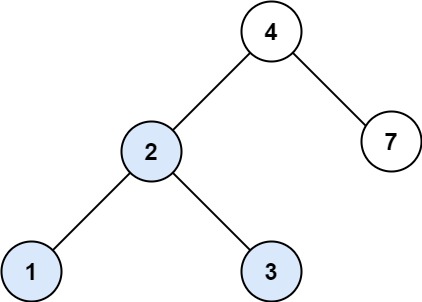
输入:root = [4,2,7,1,3], val = 2
输出:[2,1,3]
示例 2:
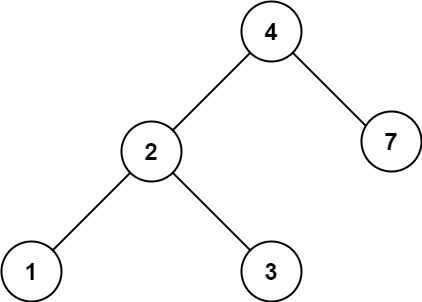
输入:root = [4,2,7,1,3], val = 5
输出:[]
提示:
- 数中节点数在
[1, 5000]范围内 1 <= Node.val <= 107root是二叉搜索树1 <= val <= 107
思路分析
最直观的方法其实就是按照普通二叉树去挨个结点遍历,找到等于val的结点返回即可。什么先序、中序、后序、层序自己选一个喜欢的就行。如下:
层序遍历:
public TreeNode searchBST(TreeNode root, int val) {
Queue<TreeNode> queue = new ArrayDeque<>();
queue.add(root);
while(!queue.isEmpty()) {
TreeNode node = queue.poll();
if (node.val == val) return node;
if (node.left != null) queue.add(node.left);
if (node.right != null) queue.add(node.right);
}
return null;
}
先序遍历:
public TreeNode searchBST1(TreeNode root, int val) {
// 终止条件
if (root == null || root.val == val) return root;
TreeNode left = searchBST1(root.left, val);
if (left != null ) return left;
return searchBST1(root.right, val);
}
但是这样写就违背这道题的初衷了,也没有用到 二叉搜索树的性质,什么性质呢?
- 对于一个结点,如果它的左右子树不为空,那么就有:
- 左子树上的所有结点的值都小于该结点的值
- 右子树上的所有结点的值都大于该结点的值
那么它相较于普通二叉树的搜索来说多了一层判断:
递归:
// 二叉树搜索树--递归
public TreeNode searchBST2(TreeNode root, int val) {
// 终止条件
if (root == null || root.val == val) return root;
TreeNode result = null;
// 去右子树查找
if (root.val < val) result = searchBST2(root.right,val);
// 去左子树查找
if (root.val > val) result = searchBST2(root.left,val);
return result;
}
迭代:
// 二叉搜索树 -迭代
public TreeNode searchBST3(TreeNode root, int val) {
// 大于val,去左子树查找
// 小于val,去右子树查找
// 等于val,直接返回
while(root != null) {
if (root.val > val) root = root.left;
else if (root.val < val) root = root.right;
else return root;
}
return null;
}
98. 验证二叉搜索树
给你一个二叉树的根节点 root ,判断其是否是一个有效的二叉搜索树。
有效 二叉搜索树定义如下:
- 节点的左子树只包含 小于 当前节点的数。
- 节点的右子树只包含 大于 当前节点的数。
- 所有左子树和右子树自身必须也是二叉搜索树。
示例 1:
输入:root = [2,1,3]
输出:true
示例 2:
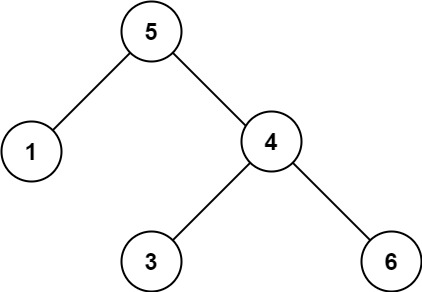
输入:root = [5,1,4,null,null,3,6]
输出:false
解释:根节点的值是 5 ,但是右子节点的值是 4 。
提示:
- 树中节点数目范围在
[1, 104]内 -231 <= Node.val <= 231 - 1
思路分析
第一种方法:
将二叉树中序遍历,遍历的元素放放到集合中,判断集合是否有序 (如果是搜索树那么中序遍历一定是从小到大排列)
public boolean isValidBST1(TreeNode root) {
ArrayList<Integer> res = new ArrayList<>();
dfs(root,res);
for (int i = 1; i < res.size(); i++) {
// 如果是搜索树,res一定是从小到大排
if (res.get(i) <= res.get(i-1)) return false;
}
return true;
}
// 中序遍历
public void dfs(TreeNode root, List<Integer> res) {
if (root == null) return;
// 左
dfs(root.left,res);
// 根
res.add(root.val);
// 右
dfs(root.right,res);
}
第二种方法:
二叉搜索树的中序遍历一定是升序的,因此我们可以判断当前结点是否比上一个节点大,如果小于或者等于,说明不满足二叉搜索树。
// 中序遍历
public boolean isValidBST(TreeNode root) {
if (root == null) return true;
// 左
boolean left = isValidBST(root.left);
// 根, 中序遍历二叉搜索树是升序的,判断当前结点是否比上一个节点大,如果小于或者等于,就不是一颗二叉搜索树
if (root.val <= minValue) return false;
minValue = (long) root.val;
// 右
boolean right = isValidBST(root.right);
return left && right;
}
530. 二叉搜索树的最小绝对差
给你一个二叉搜索树的根节点 root ,返回 树中任意两不同节点值之间的最小差值 。
差值是一个正数,其数值等于两值之差的绝对值。
示例 1:
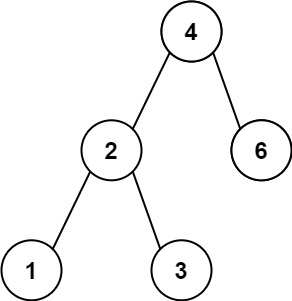
输入:root = [4,2,6,1,3]
输出:1
示例 2:
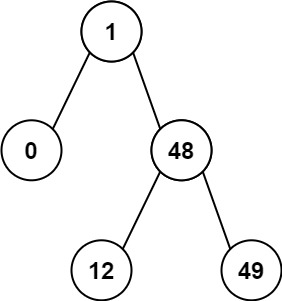
输入:root = [1,0,48,null,null,12,49]
输出:1
提示:
- 树中节点的数目范围是
[2, 104] 0 <= Node.val <= 105
思路分析
依然利用二叉搜索树的行: 左子树 < 根节点 < 右子树, 那么中序遍历: 左 -- 根 -- 右,遍历出来的一定是一个升序数组。
可以先利用中序遍历保存到一个集合中,然后遍历集合求相邻俩个结点的差,找出最小的即可。
也可以在遍历过程中,维护一个变量,保存上一个结点的值,不断更新这个变量,并且求出当前结点与这个变量的差。
// 用来保存结果值
private Integer res = -2000000;
// 保存遍历的上一个结点的值
private Integer pre = Integer.MAX_VALUE;
public int getMinimumDifference(TreeNode root) {
dfs(root);
return res;
}
/**
* 二叉搜索树的最小绝对差,只可能出现在相邻的结点中
* 1、左孩子结点 和 父节点
* 2、父节点 和 右孩子结点
* 因此我们需要保存上一个结点的值
* */
public void dfs(TreeNode root) {
if (root == null) return;
dfs(root.left);
res = Math.min(res,root.val - pre);
pre = root.val;
dfs(root.right);
}
技巧:
在递归遍历的过程中,一定要学会记录前后俩个指针。
501. 二叉搜索树中的众数
给你一个含重复值的二叉搜索树(BST)的根节点 root ,找出并返回 BST 中的所有 众数(即,出现频率最高的元素)。
如果树中有不止一个众数,可以按 任意顺序 返回。
假定 BST 满足如下定义:
- 结点左子树中所含节点的值 小于等于 当前节点的值
- 结点右子树中所含节点的值 大于等于 当前节点的值
- 左子树和右子树都是二叉搜索树
示例 1:
输入:root = [1,null,2,2]
输出:[2]
示例 2:
输入:root = [0]
输出:[0]
提示:
- 树中节点的数目在范围
[1, 104]内 -105 <= Node.val <= 105
**进阶:**你可以不使用额外的空间吗?(假设由递归产生的隐式调用栈的开销不被计算在内)
思路分析
如果是普通二叉树,我们这道题该如何做呢?
遍历二叉树,然后使用map统计二叉树出现的次数,然后将map按照出现的次数升序,最后取出频率最高的结点即可。
这道题也可以这样做,但是这就失去了这道题的意义,如何利用二叉搜索树的性质解决这道题呢?
二叉搜索树的中序遍历一定是升序的(这句话背下来) ,因此它相同的结点一定是相邻的。
那么好了,我们又要用到上面的技巧了,在遍历的过程需要记录上一个结点的值,我们需要判断 当前结点 是否和上一个结点相同,如果相等我们就记录次数 count++。如果不相等,就将次数count 恢复成 1 。
并且我们还需要一个变量maxCount 记录出现的最大频率,如果 count == maxCount 我们就记录这个结点,代码如下:
if (count == maxCount) {
res.add(root.val);
}
但是问题来了,我们怎么知道当前结点出现的频率是不是最高的呢? 因此我们还需要再多一层比较,如果count > maxCount 就说明当前结点比上一个结点出现的频率要高,因此清空res集合,将当前结点重新加入进去。
完整代码如下:
// 上一个结点的值
private Integer pre = Integer.MIN_VALUE ;
// 记录结点出现的频率
private Integer count= 0;
// 记录遍历时出现的最大频率
private Integer maxCount = 0;
private List<Integer> res = new ArrayList<>();
public int[] findMode(TreeNode root) {
dfs(root);
int[] ints = new int[res.size()];
for (int i = 0; i < res.size(); i++) {
ints[i] = res.get(i);
}
return ints;
}
public void dfs(TreeNode root){
if (root == null) return;
dfs(root.left);
// 统计出现的频率
if(root.val == pre) {
count++;
}else {
count=1;
}
if (count == maxCount) {
// 说明遍历到当前结点为止,该结点的值已经是出现的频率最高了,因此需要将当前节点的值放入集合中
// 但是并不代表 遍历完所有结点后,当前结点的值出现的频率还是最高
res.add(root.val);
}else if (count > maxCount){
// 此时 count > maxCount,说明已经出现比上一个元素出现频率更高的元素了。
// 因此需要将上一个元素清空,并重新记录当前这个频率更高的元素
res.clear();
res.add(root.val);
maxCount = count;
}
pre = root.val;
dfs(root.right);
}
236. 二叉树的最近公共祖先
给定一个二叉树, 找到该树中两个指定节点的最近公共祖先。
百度百科中最近公共祖先的定义为:“对于有根树 T 的两个节点 p、q,最近公共祖先表示为一个节点 x,满足 x 是 p、q 的祖先且 x 的深度尽可能大(一个节点也可以是它自己的祖先)。”
示例 1:
输入:root = [3,5,1,6,2,0,8,null,null,7,4], p = 5, q = 1
输出:3
解释:节点 5 和节点 1 的最近公共祖先是节点 3 。
示例 2:
输入:root = [3,5,1,6,2,0,8,null,null,7,4], p = 5, q = 4
输出:5
解释:节点 5 和节点 4 的最近公共祖先是节点 5 。因为根据定义最近公共祖先节点可以为节点本身。
示例 3:
输入:root = [1,2], p = 1, q = 2
输出:1
提示:
- 树中节点数目在范围
[2, 105]内。 -109 <= Node.val <= 109- 所有
Node.val互不相同。 p != qp和q均存在于给定的二叉树中。
思路分析
公共祖先:简单来说就是一个或多个结点的共同父节点(若只有一个结点,本身也是公共祖先)
先来讨论一下几种情况,假设 root 为 p、q的公共祖先,那么一共有以下几种情况:
- q和p在二叉树的异侧,即一个在左子树一个在右子树
- p = root,即q在p的左子树或者右子树
- q=root,即p在q的右子树或者左子树
根据以上条件,我们可以定义一个递归,用来寻找公共祖先:
终止条件:
- $root == null$ 则返回 root
- $root == q || root == p$ , 则直接返回 root
返回值:
由于我们使用的是递归,默认左右子树已经有结果,即用 **left ** 和 right 表示:
- 若
left == null,则公共祖先在右子树,返回 right - 若
right == null,则公共祖先在左子树,返回 left - 如果
root != null && right != null, 说明 p 和 q在root的左右子树中,即 root 就是公共祖先,返回 root - 若
root == null && right == null,则不存在公共祖先,返回NULL (此步判断其实已经包在 1 和 2里)
public TreeNode lowestCommonAncestor(TreeNode root, TreeNode p, TreeNode q) {
if ( root == q || root == p || root == null) return root;
TreeNode left = lowestCommonAncestor(root.left,p,q); // 遍历左子树
TreeNode right = lowestCommonAncestor(root.right,p,q); // 遍历右子树
// 如果左子树为空,说明 最近的公共祖先在右子树上,返回right
if (left == null) return right;
// 同理,右子树为空,说明左子树上存在公共祖先
if (right == null) return left;
// 如果 left和right都不为空,说明当前结点就是公共祖先
return root;
}
235. 二叉搜索树的最近公共祖先
给定一个二叉搜索树, 找到该树中两个指定节点的最近公共祖先。
百度百科中最近公共祖先的定义为:“对于有根树 T 的两个结点 p、q,最近公共祖先表示为一个结点 x,满足 x 是 p、q 的祖先且 x 的深度尽可能大(一个节点也可以是它自己的祖先)。”
例如,给定如下二叉搜索树: root = [6,2,8,0,4,7,9,null,null,3,5]
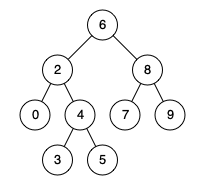
示例 1:
输入: root = [6,2,8,0,4,7,9,null,null,3,5], p = 2, q = 8
输出: 6
解释: 节点 2 和节点 8 的最近公共祖先是 6。
示例 2:
输入: root = [6,2,8,0,4,7,9,null,null,3,5], p = 2, q = 4
输出: 2
解释: 节点 2 和节点 4 的最近公共祖先是 2, 因为根据定义最近公共祖先节点可以为节点本身。
说明:
- 所有节点的值都是唯一的。
- p、q 为不同节点且均存在于给定的二叉搜索树中。
思路分析
利用二叉搜索树的性质:
- 如果 root.val 比 q、p都大,说明公共祖先在 root 的左子树上
- 如果 root.val 比 q、p都小,说明公共祖先在 root 的右子树上
- 如果 root.val 在 [p,q]或者[q,p] 区间之内,说明root就是公共祖先
public TreeNode lowestCommonAncestor(TreeNode root, TreeNode p, TreeNode q) {
// 如果 root 比 q、p都大说明在root的左边
if (root.val > q.val && root.val > p.val) return lowestCommonAncestor(root.left,p,q);
// 如果 root 比 q、p都小说明在root的左右边
if (root.val < q.val && root.val < p.val) return lowestCommonAncestor(root.right,p,q);
// 如果 root在 [p,q]的区间之内,说明root就是公共祖先
return root;
}
701. 二叉搜索树中的插入操作
给定二叉搜索树(BST)的根节点 root 和要插入树中的值 value ,将值插入二叉搜索树。 返回插入后二叉搜索树的根节点。 输入数据 保证 ,新值和原始二叉搜索树中的任意节点值都不同。
注意,可能存在多种有效的插入方式,只要树在插入后仍保持为二叉搜索树即可。 你可以返回 任意有效的结果 。
示例 1:

输入:root = [4,2,7,1,3], val = 5
输出:[4,2,7,1,3,5]
解释:另一个满足题目要求可以通过的树是:
示例 2:
输入:root = [40,20,60,10,30,50,70], val = 25
输出:[40,20,60,10,30,50,70,null,null,25]
示例 3:
输入:root = [4,2,7,1,3,null,null,null,null,null,null], val = 5
输出:[4,2,7,1,3,5]
提示:
- 树中的节点数将在
[0, 104]的范围内。 -108 <= Node.val <= 108- 所有值
Node.val是 独一无二 的。 -108 <= val <= 108- 保证
val在原始BST中不存在。
思路分析
题目中说,二叉搜索树中的任意一个结点都不相同,并且val在二叉树中不存在。
那么我们就可以直接遍历二叉搜索树,找到一个空的位置插入即可。
- 当前结点值 < val 就去右子树搜索
- 当前结点值 > val 就去左子树搜索
- 如果当前节点值为空,则该位置就是要插入的位置
递归
// 递归
public TreeNode insertIntoBST(TreeNode root, int val) {
if (root == null) return new TreeNode(val);
// 递归左右子树,如果小于val,就去右子树搜索。相反则去左子树上去搜索
if (root.val < val) root.right = insertIntoBST(root.right,val);
if (root.val > val) root.left = insertIntoBST(root.left,val);
return root;
}
迭代
public TreeNode insertIntoBST1(TreeNode root, int val) {
if (root == null) return new TreeNode(val);
TreeNode cur = root;
while(cur != null) {
if (cur.val < val) {
// 去右子树上搜素
if (cur.right == null) {
// 右子树为空,直接插入
cur.right = new TreeNode(val);
break;
}else {
// 如果不为空,继续往下遍历
cur = cur.right;
}
}else {
// 左子树上去搜索
if (cur.left == null) {
cur.left = new TreeNode(val);
break;
}else {
cur = cur.left;
}
}
}
return root;
}
450. 删除二叉搜索树中的节点
给定一个二叉搜索树的根节点 root 和一个值 key,删除二叉搜索树中的 key 对应的节点,并保证二叉搜索树的性质不变。返回二叉搜索树(有可能被更新)的根节点的引用。
一般来说,删除节点可分为两个步骤:
- 首先找到需要删除的节点;
- 如果找到了,删除它。
示例 1:

输入:root = [5,3,6,2,4,null,7], key = 3
输出:[5,4,6,2,null,null,7]
解释:给定需要删除的节点值是 3,所以我们首先找到 3 这个节点,然后删除它。
一个正确的答案是 [5,4,6,2,null,null,7], 如下图所示。
另一个正确答案是 [5,2,6,null,4,null,7]。
示例 2:
输入: root = [5,3,6,2,4,null,7], key = 0
输出: [5,3,6,2,4,null,7]
解释: 二叉树不包含值为 0 的节点
示例 3:
输入: root = [], key = 0
输出: []
提示:
- 节点数的范围
[0, 104]. -105 <= Node.val <= 105- 节点值唯一
root是合法的二叉搜索树-105 <= key <= 105
进阶: 要求算法时间复杂度为 O(h),h 为树的高度。
思路分析
二叉搜索树的题目往往都可以使用递归来解决
结束条件
当 root 为空的时候,则返回 root
返回值
在二叉搜索树的插入中,用返回值确定插入的结点,此处也可以用返回值来确定要删除的结点
单层递归逻辑
此处就是删除结点的逻辑,我们需要分情况讨论:
- 没有找到删除的结点,遍历到空结点直接返回
- 找到删除的结点,假设为root
- 第一种情况:root为叶子结点,即没有左右子树,直接删除即可,返回 NULL
- 第二种情况:左子树不为空,右子树为空,返回左子树代替删除结点root
- 第三种情况:右子树不为空,左子树为空,返回右子树代替删除节点root
- 第四种情况:也是最复杂的情况,左右子树均不为空时,将 root 的左子树移动到 root 的右子树的最左侧结点的左子树上(即root的右子树最小结点上),如图所示:
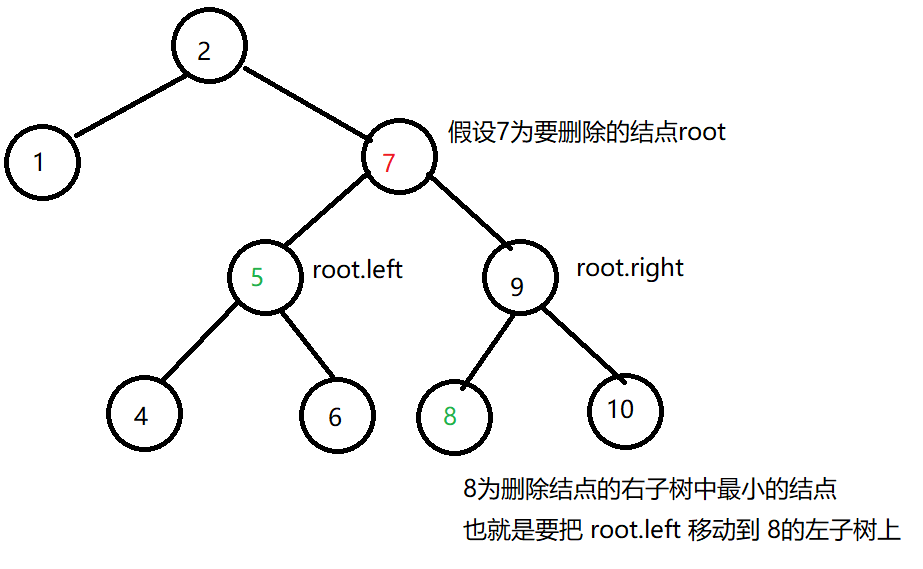
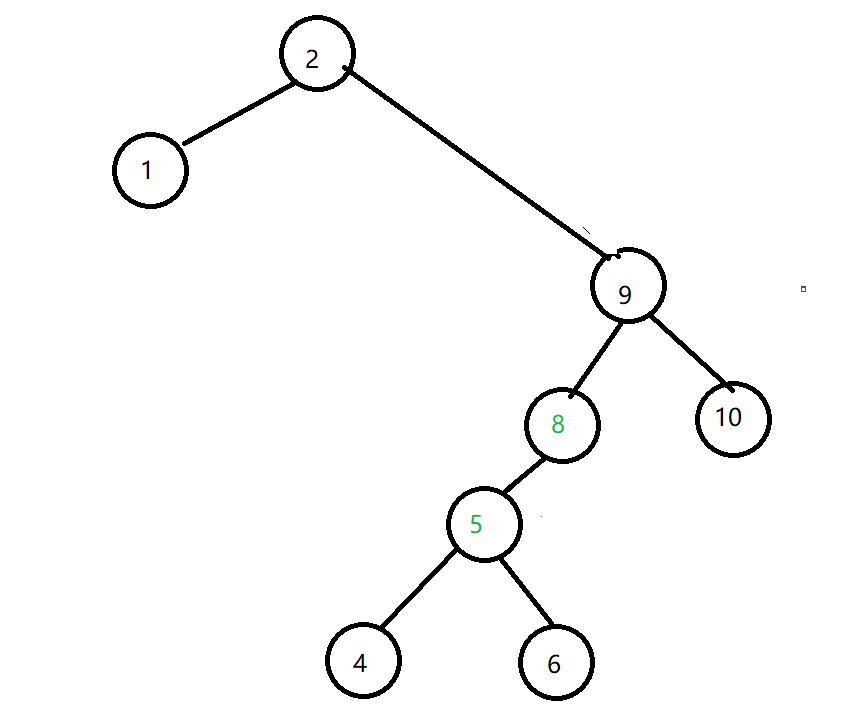
public TreeNode deleteNode(TreeNode root, int key) {
if (root == null) return root;
if (root.val == key) {
// 此时root为要删除的结点
// 第一种情况:左右子树都为空,直接删除结点
if (root.right == null && root.left == null) return null;
// 第二种情况:左子树不为空,右子树为空,返回左子树为新的子树
if (root.right == null) return root.left;
// 第三种情况:左子树为空,右子树不为空,返回右子树为新的子树
if (root.left == null) return root.right;
// 第四种情况:左右子树都不为空
TreeNode cur = root.right;
// 移动到要删除结点的右子树的最左边的结点(删除结点右子树的最小值)
while (cur.left != null) cur = cur.left;
// 删除操作
// 将删除结点的左子树移动到 删除结点的右子树中最小结点的左子树上
cur.left = root.left;
// 覆盖删除结点
root = root.right;
return root;
}
if (root.val > key) root.left = deleteNode(root.left, key);
if (root.val < key) root.right = deleteNode(root.right, key);
return root;
}
669. 修剪二叉搜索树
给你二叉搜索树的根节点 root ,同时给定最小边界low 和最大边界 high。通过修剪二叉搜索树,使得所有节点的值在[low, high]中。修剪树 不应该 改变保留在树中的元素的相对结构 (即,如果没有被移除,原有的父代子代关系都应当保留)。 可以证明,存在 唯一的答案 。
所以结果应当返回修剪好的二叉搜索树的新的根节点。注意,根节点可能会根据给定的边界发生改变。
示例 1:

输入:root = [1,0,2], low = 1, high = 2
输出:[1,null,2]
示例 2:
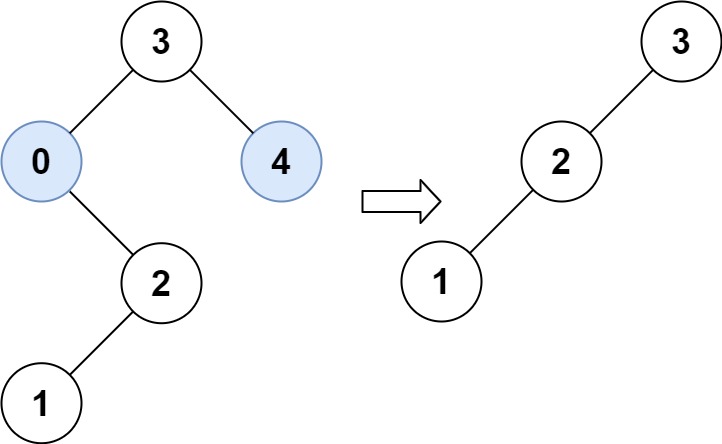
输入:root = [3,0,4,null,2,null,null,1], low = 1, high = 3
输出:[3,2,null,1]
提示:
- 树中节点数在范围
[1, 104]内 0 <= Node.val <= 104- 树中每个节点的值都是 唯一 的
- 题目数据保证输入是一棵有效的二叉搜索树
0 <= low <= high <= 104
思路分析
这道题其实和 450 道题差不多,无非就是一个删除单个结点,该题可能删除多个结点。
public TreeNode trimBST(TreeNode root, int low, int high) {
if (root == null) return root;
root.right = trimBST(root.right, low, high);
root.left = trimBST(root.left, low, high);
if (!(root.val <= high && root.val >= low)) {
// 找到修剪的结点
// 第一种情况:左右子树都为null,直接返回null
if (root.left == null && root.right == null) return null;
// 第二种情况:左子树为空,右子树不为空,返回右子树为新的子树
if (root.left == null) return root.right;
// 第三种情况:左子树不为空,右子树为空,返回左子树为新的子树
if (root.right == null) return root.left;
// 第四种情况:当左右子树都不为空时,将 删除结点的左子树 移动到删除节点右子树中最小的结点
TreeNode curr = root.right;
while (curr.left != null) {
curr = curr.left;
}
// 将删除结点的左子树移动到cur的左子树上
curr.left = root.left;
root = root.right;
return root;
}
return root;
}
但是我们大可不必这么麻烦,题目中给了 [low,high] 区间,那么:
- 当
root.val > high时,说明root的整颗右子树都要修剪掉,我们直接跳过root结点及右子树,从root.left开始递归 - 当
root.val < left时,说明root的整颗左子树都要修剪掉,我们直接跳过root结点及左子树,从root.right开始递归
public TreeNode trimBST1(TreeNode root, int low, int high) {
if (root == null) return root;
// root.val < low 不在范围内,说明root的整颗左子树都符合修剪条件,跳过root及左子树,从右子树开始递归
if (root.val < low) return trimBST1(root.right,low,high);
// 同理,root.val比最大值还大,说明root的整颗右子树都符合修剪条件,跳过root结点及右子树,递归左子树
if (root.val > high) return trimBST1(root.left,low,high);
// 此时接入上面返回的左子树或者右子树
root.left = trimBST(root.left,low,high);
root.right = trimBST(root.right,low,high);
return root;
}
108. 将有序数组转换为二叉搜索树
给你一个整数数组 nums ,其中元素已经按 升序 排列,请你将其转换为一棵 高度平衡 二叉搜索树。
高度平衡 二叉树是一棵满足「每个节点的左右两个子树的高度差的绝对值不超过 1 」的二叉树。
示例 1:
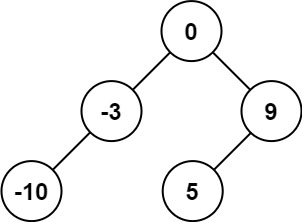
输入:nums = [-10,-3,0,5,9]
输出:[0,-3,9,-10,null,5]
解释:[0,-10,5,null,-3,null,9] 也将被视为正确答案:
示例 2:
输入:nums = [1,3]
输出:[3,1]
解释:[1,null,3] 和 [3,1] 都是高度平衡二叉搜索树。
提示:
1 <= nums.length <= 104-104 <= nums[i] <= 104nums按 严格递增 顺序排列
思路分析
在写这道题之前,建议看看
该题和上面三题思路一样,只不过是找根结点和递归的边界有所不同。
那么在 此题中,根节点为数组中间的一个,而根节点左边为左子树,根节点右边为右子树
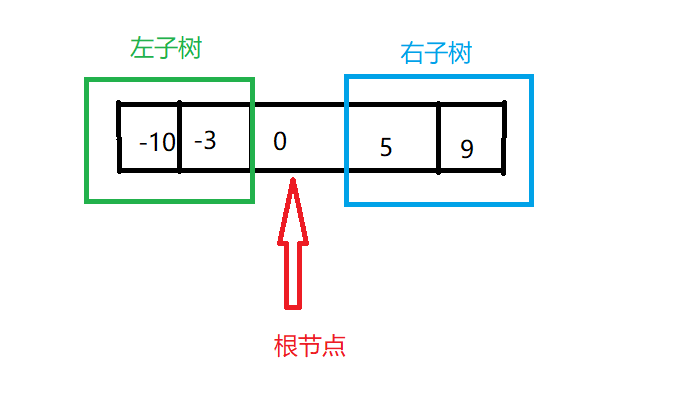
public TreeNode sortedArrayToBST(int[] nums) {
return helper(nums, 0, nums.length);
}
public TreeNode helper(int[] nums, int left, int right) {
if (left > right) return null;
// 确定根结点
int rootIndex = left(right - left) / 2;
TreeNode root = new TreeNode(nums[rootIndex]);
// 递归创建左右子树
root.left = helper(nums, left, rootIndex - 1);
root.right = helper(nums, rootIndex + 1, right);
return root;
}
538. 把二叉搜索树转换为累加树
给出二叉 搜索 树的根节点,该树的节点值各不相同,请你将其转换为累加树(Greater Sum Tree),使每个节点 node 的新值等于原树中大于或等于 node.val 的值之和。
提醒一下,二叉搜索树满足下列约束条件:
- 节点的左子树仅包含键 小于 节点键的节点。
- 节点的右子树仅包含键 大于 节点键的节点。
- 左右子树也必须是二叉搜索树。
**注意:**本题和 1038: https://leetcode-cn.com/problems/binary-search-tree-to-greater-sum-tree/ 相同
示例 1:
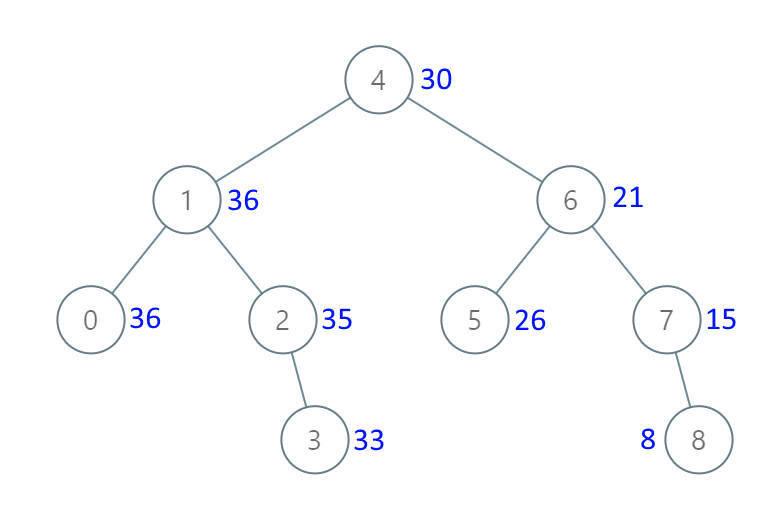
输入:[4,1,6,0,2,5,7,null,null,null,3,null,null,null,8]
输出:[30,36,21,36,35,26,15,null,null,null,33,null,null,null,8]
示例 2:
输入:root = [0,null,1]
输出:[1,null,1]
示例 3:
输入:root = [1,0,2]
输出:[3,3,2]
示例 4:
输入:root = [3,2,4,1]
输出:[7,9,4,10]
提示:
- 树中的节点数介于
0和104之间。 - 每个节点的值介于
-104和104之间。 - 树中的所有值 互不相同 。
- 给定的树为二叉搜索树。
思路分析
题目要求将结点的值改为比当前结点值 大于或等于 节点值的总和
这样可能不好理解,我举个栗子:
将二叉搜索树变成一个有序数组(中序遍历),[0,1,2,3,4,5,6,7,8] ,那么求节点4的新值,就是 4+5+6+7+8=30, 求节点5的新值为:5+6+7+8 = 26
其实就是从后到前累加节点的和!!!!
public TreeNode convertBST(TreeNode root) {
dfs(root);
return root;
}
public void dfs(TreeNode root) {
if (root == null) return;
// 从最大值开始遍历
dfs(root.right);
// 累加从后到当前节点的和
total += root.val;
root.val = total;
dfs(root.left);
}
